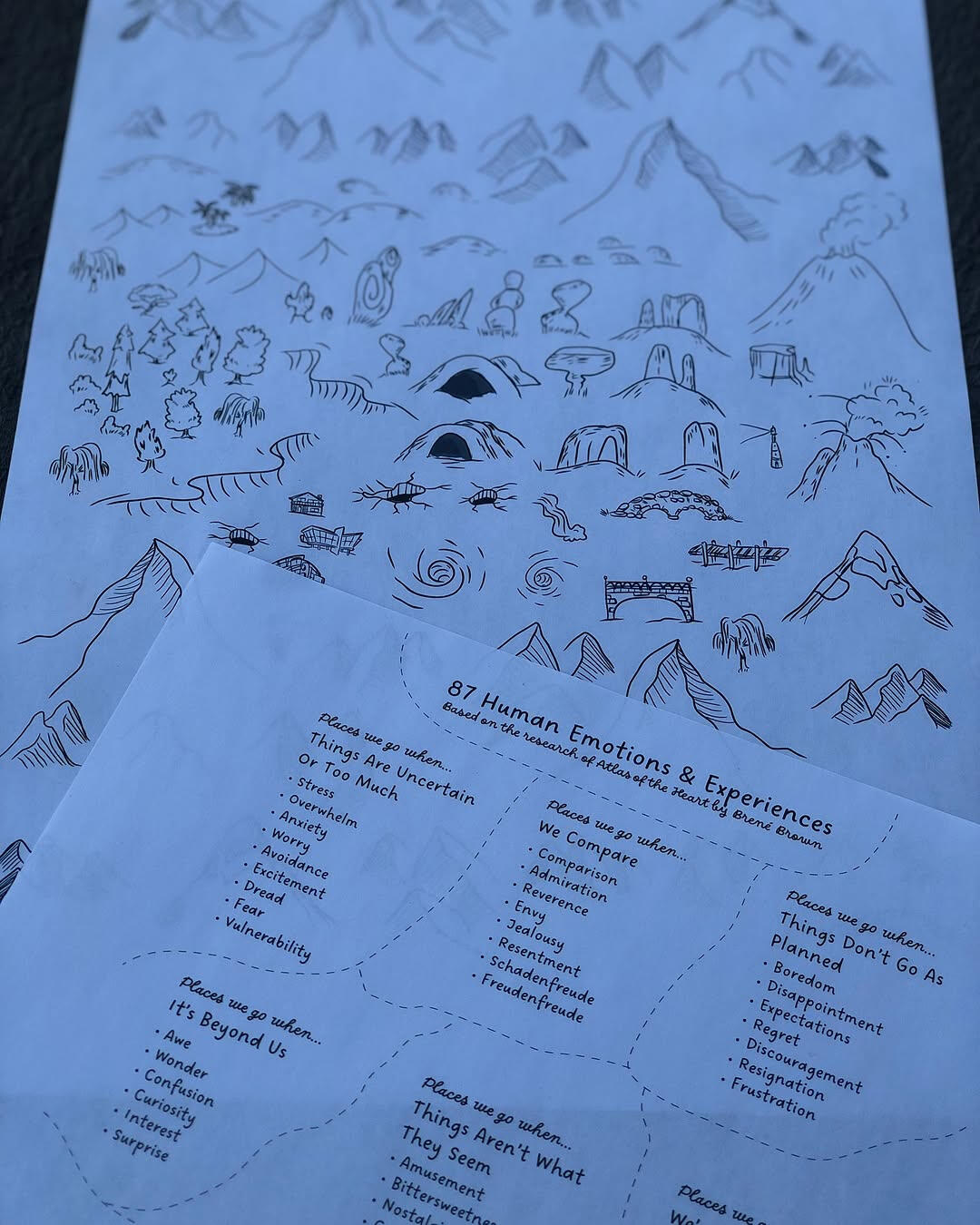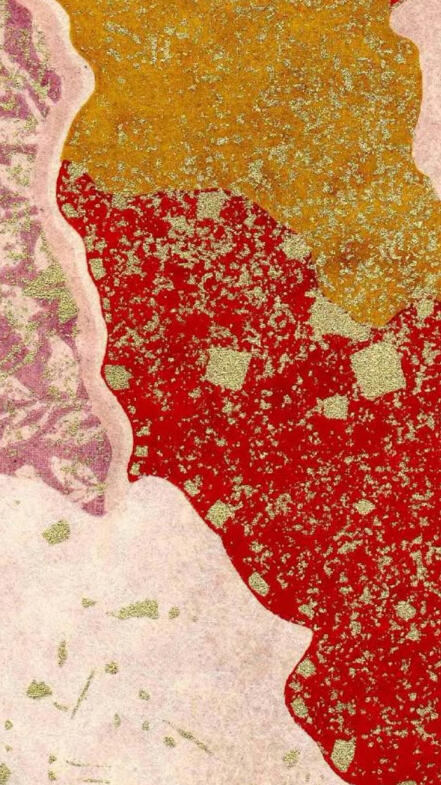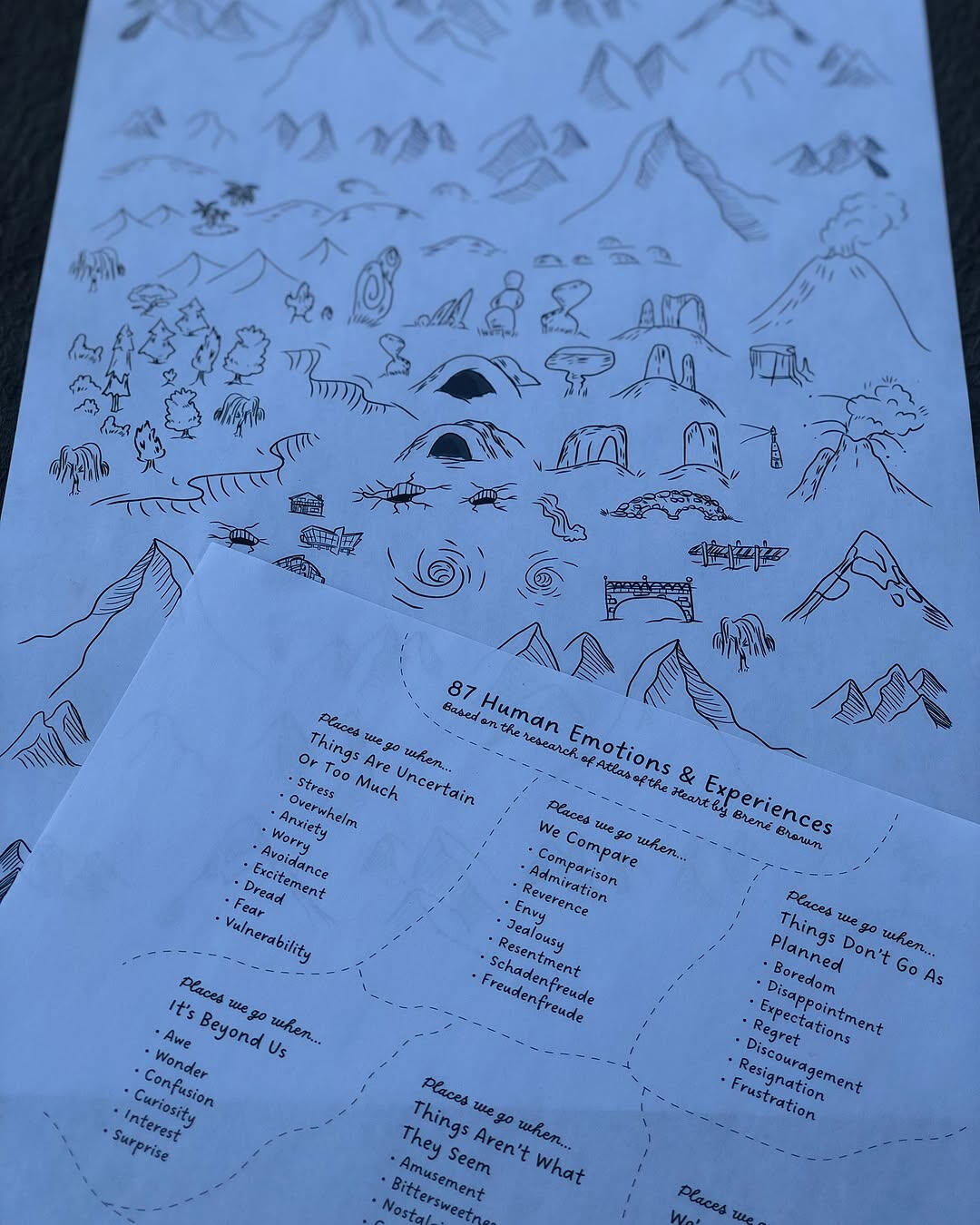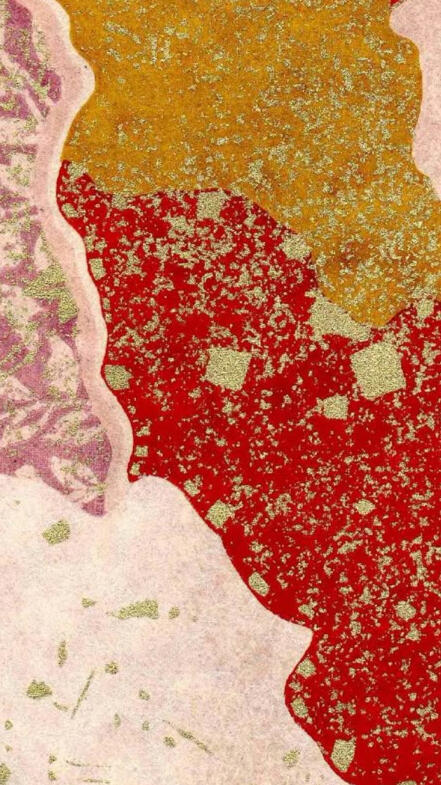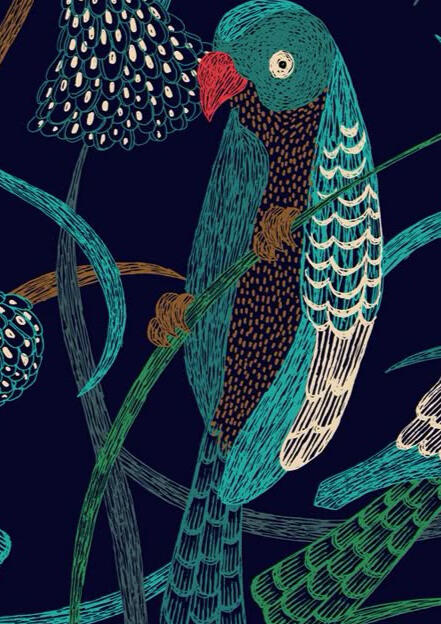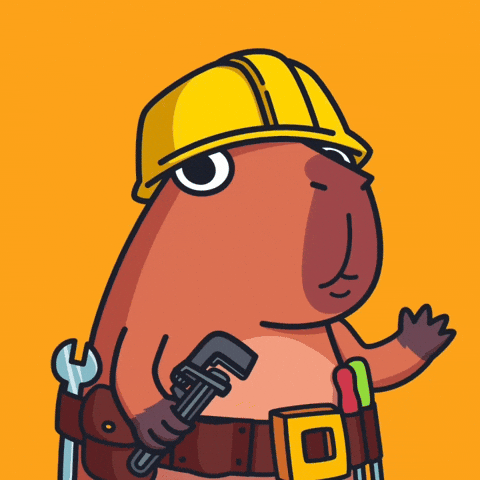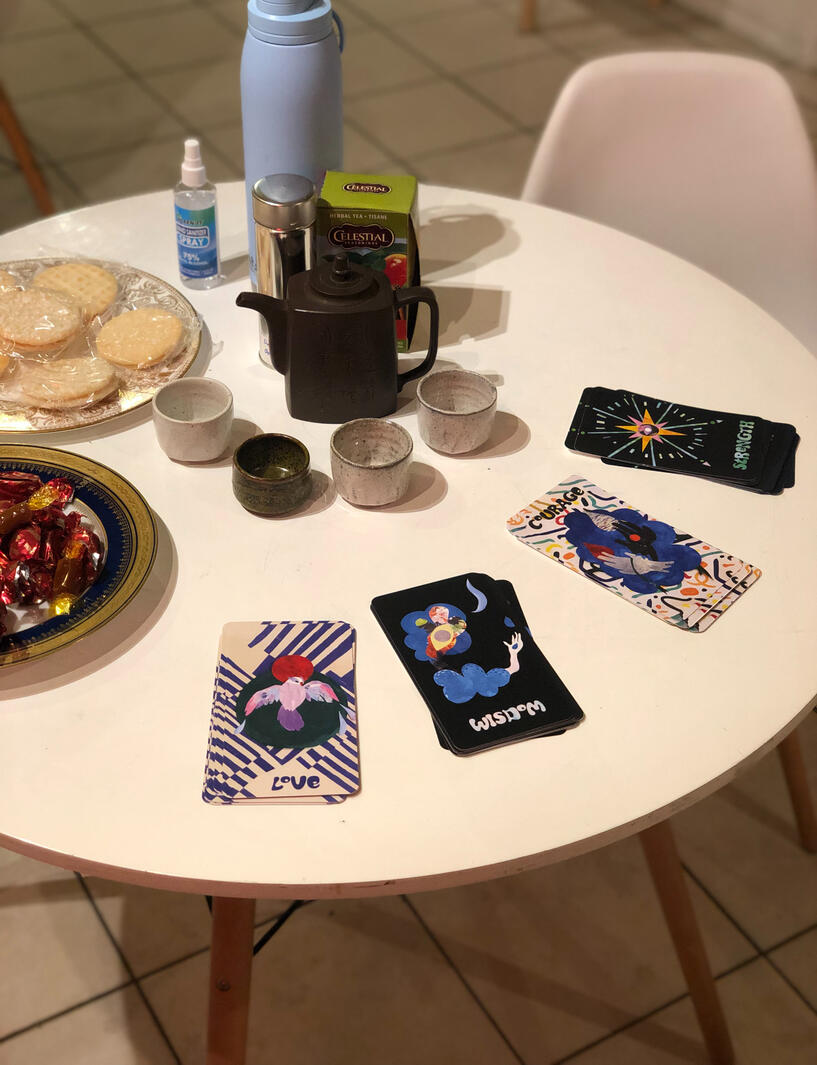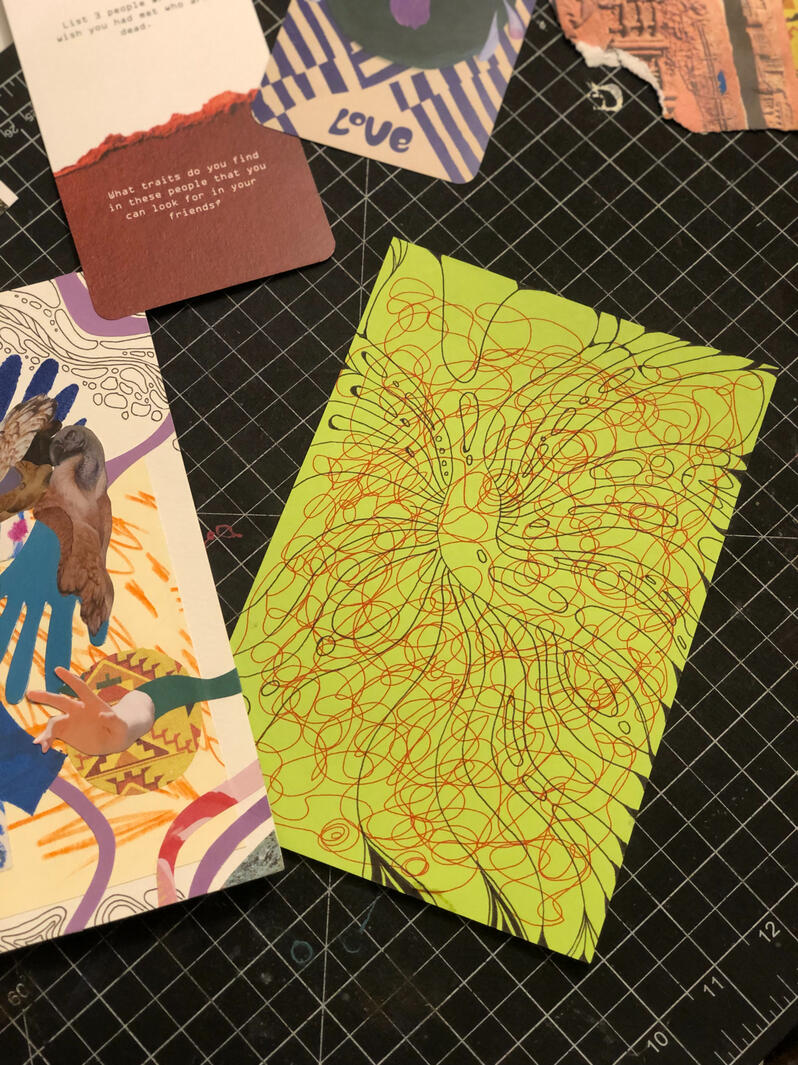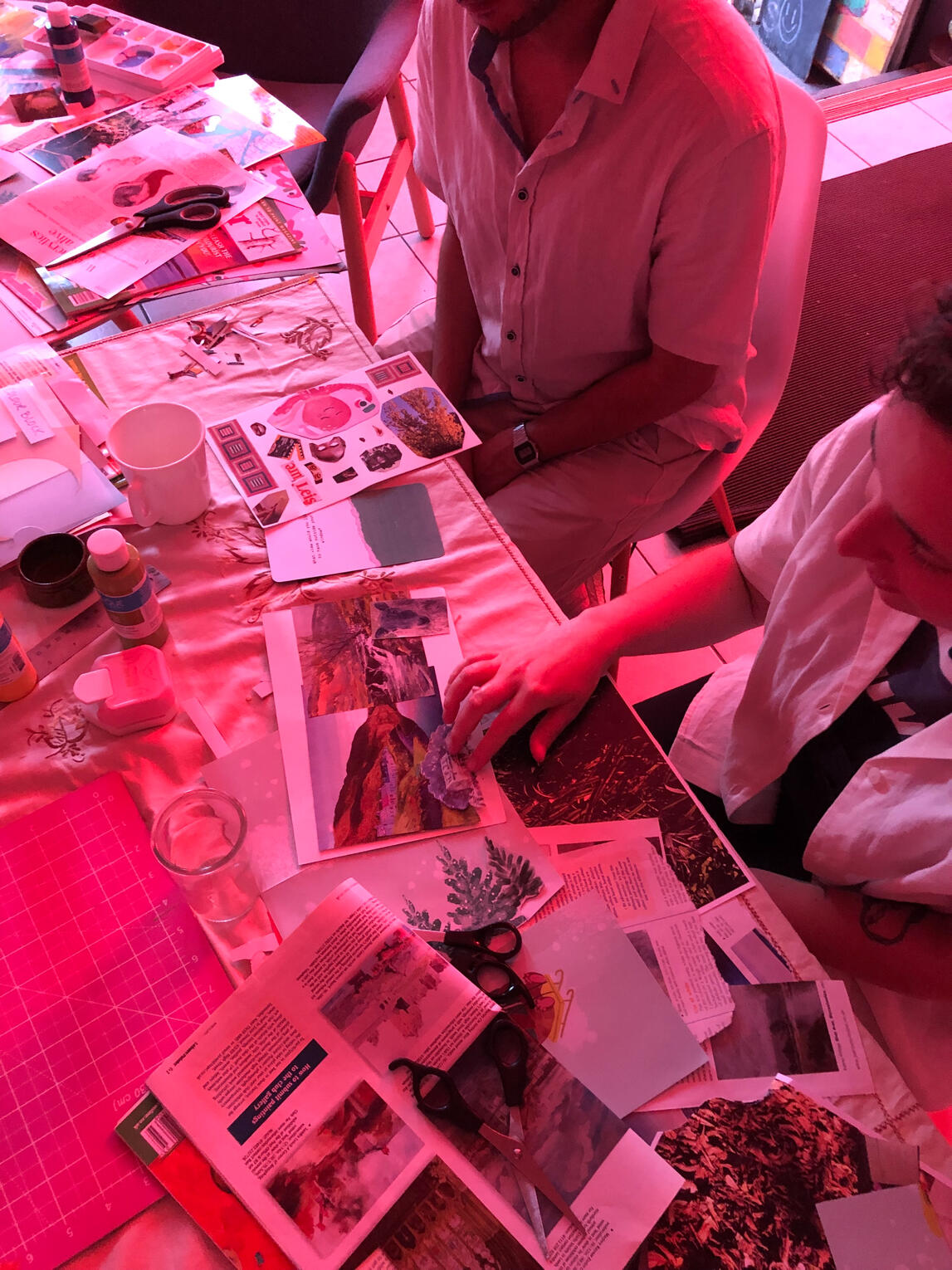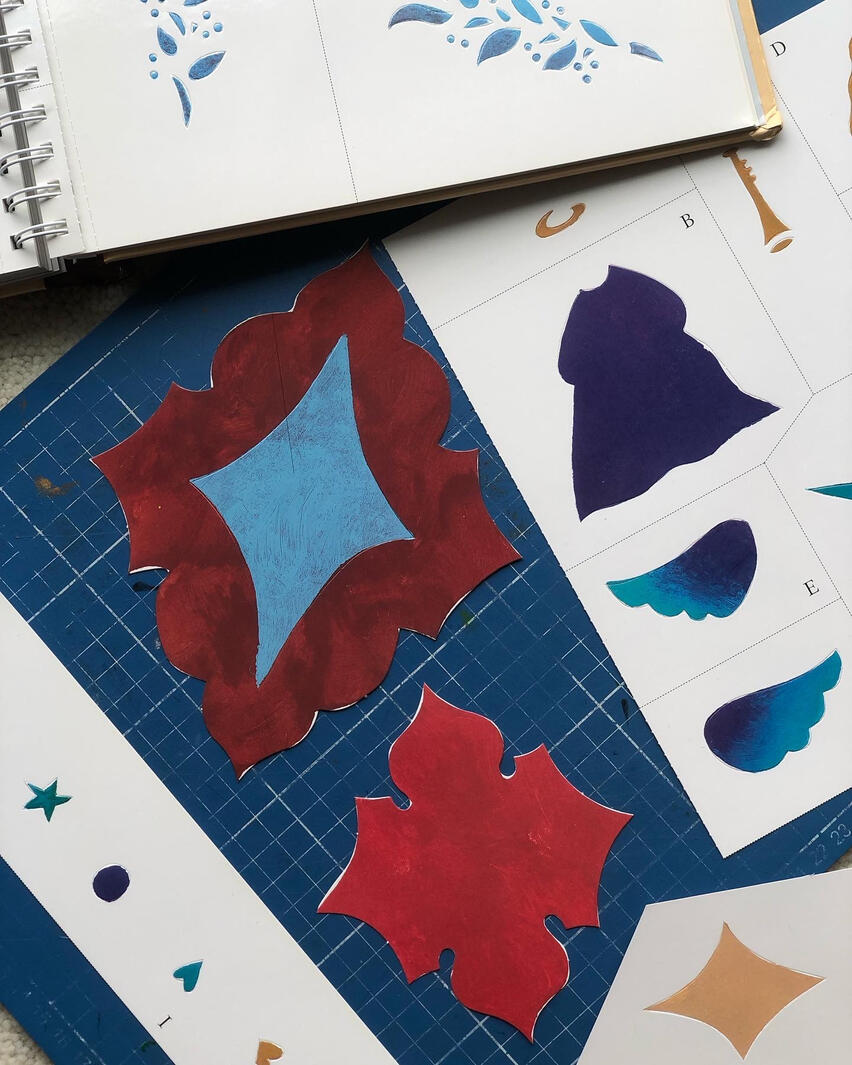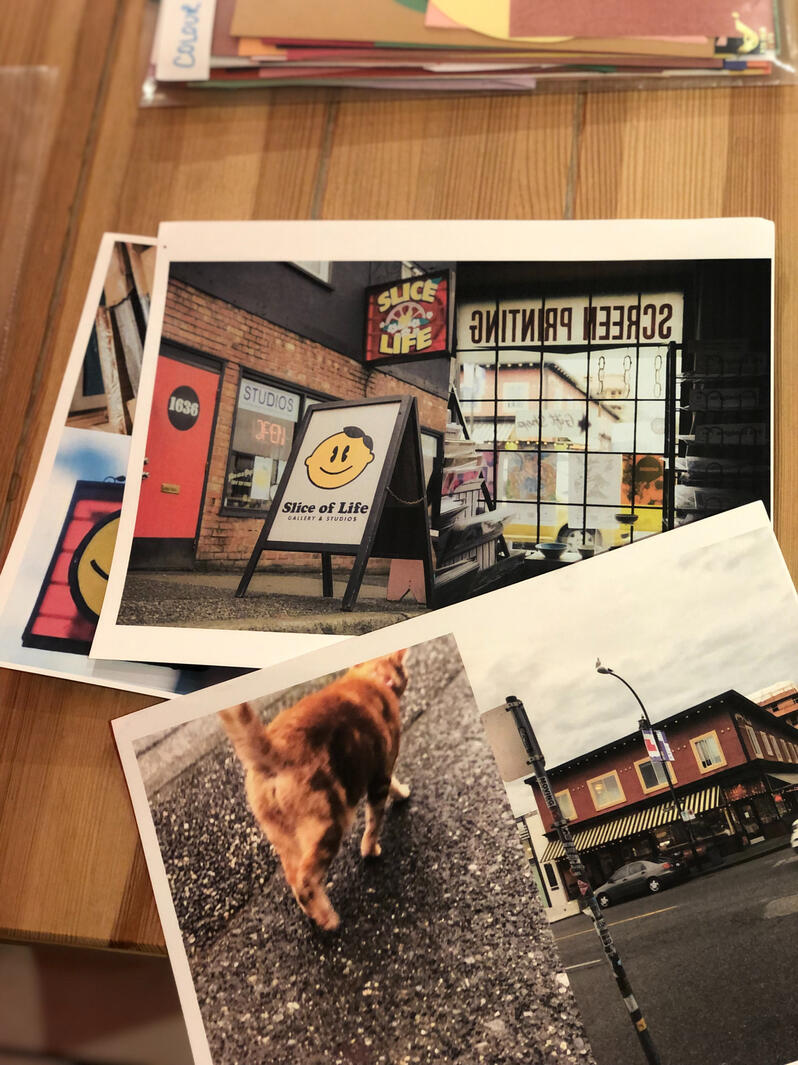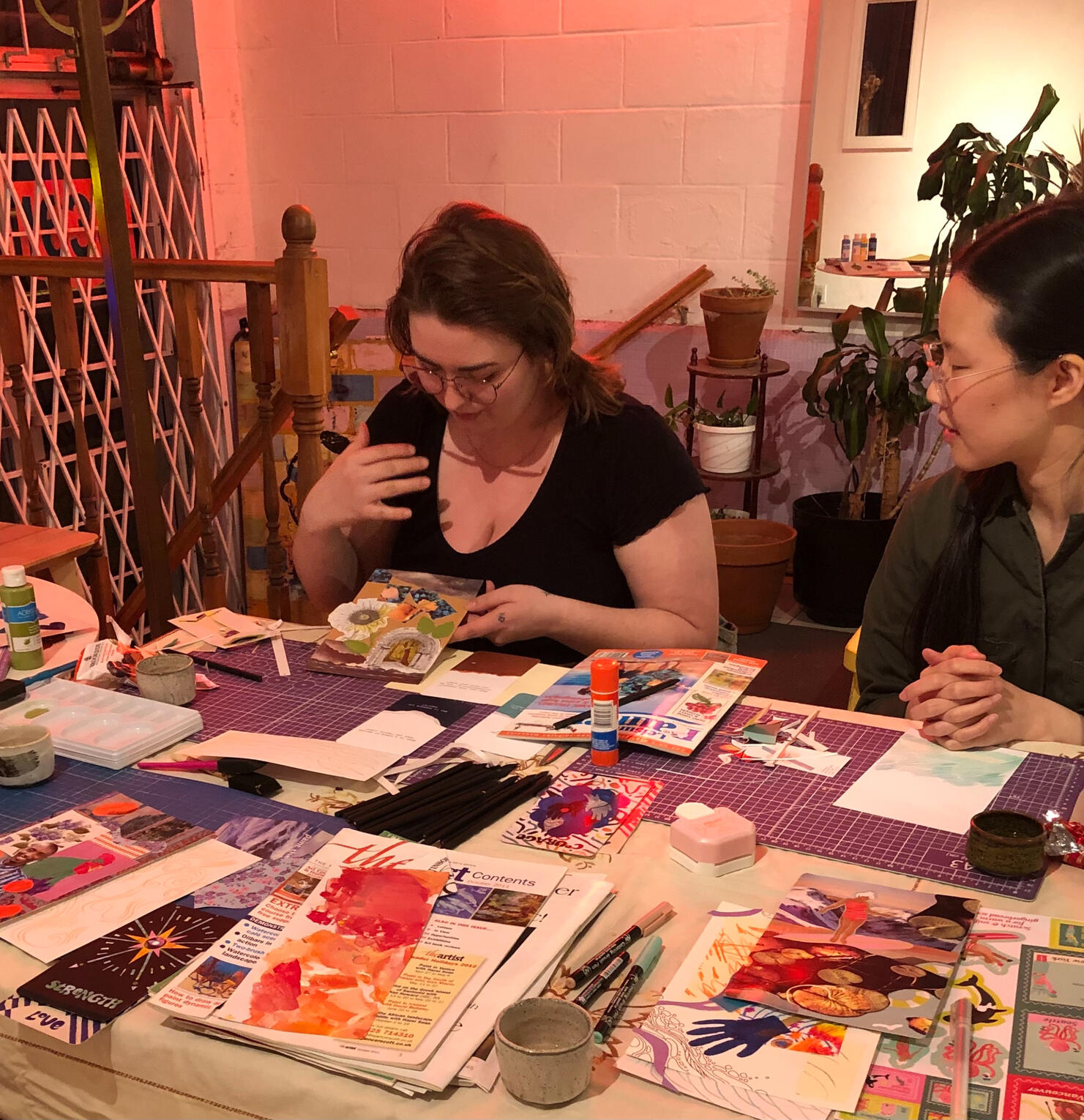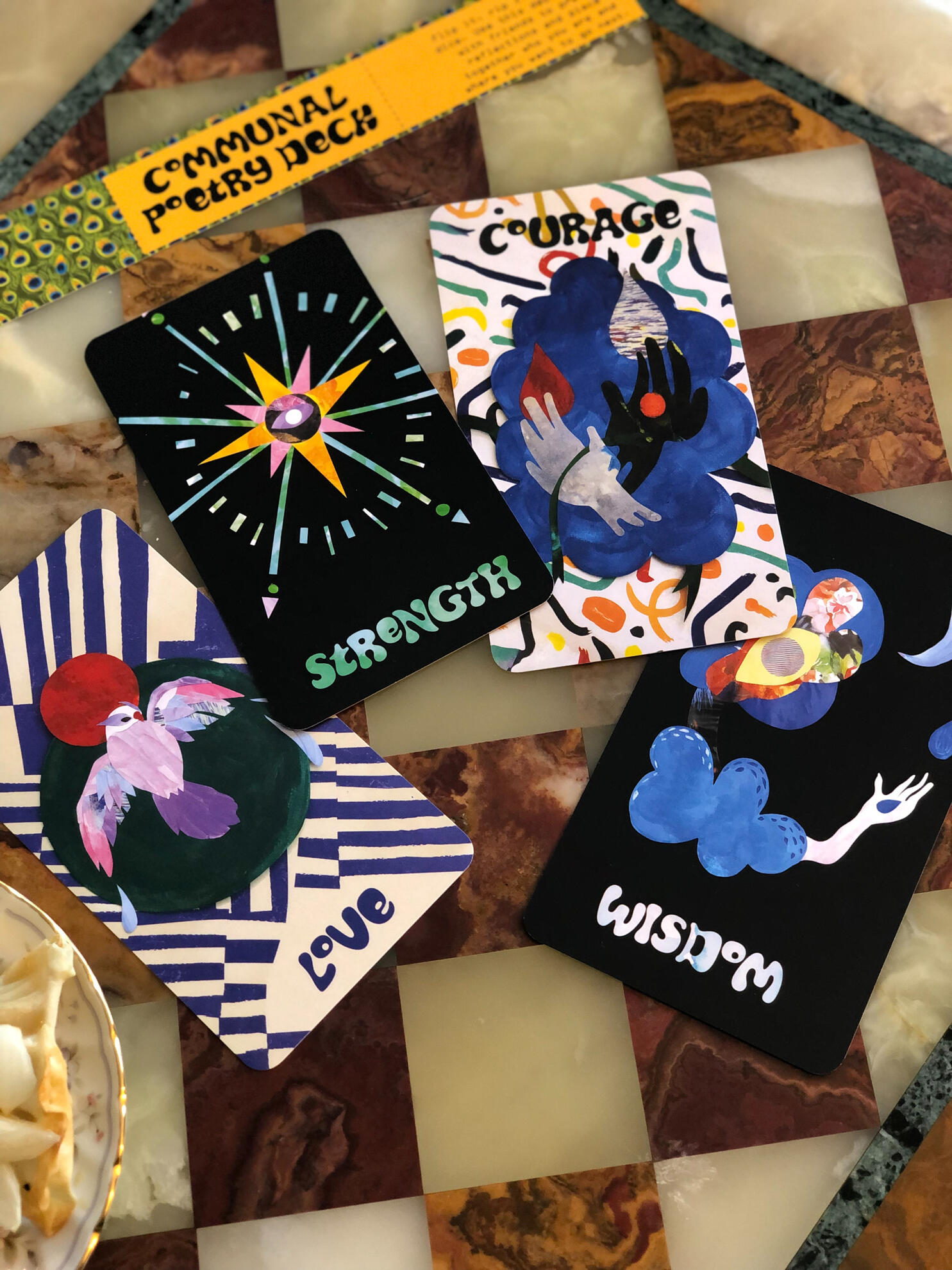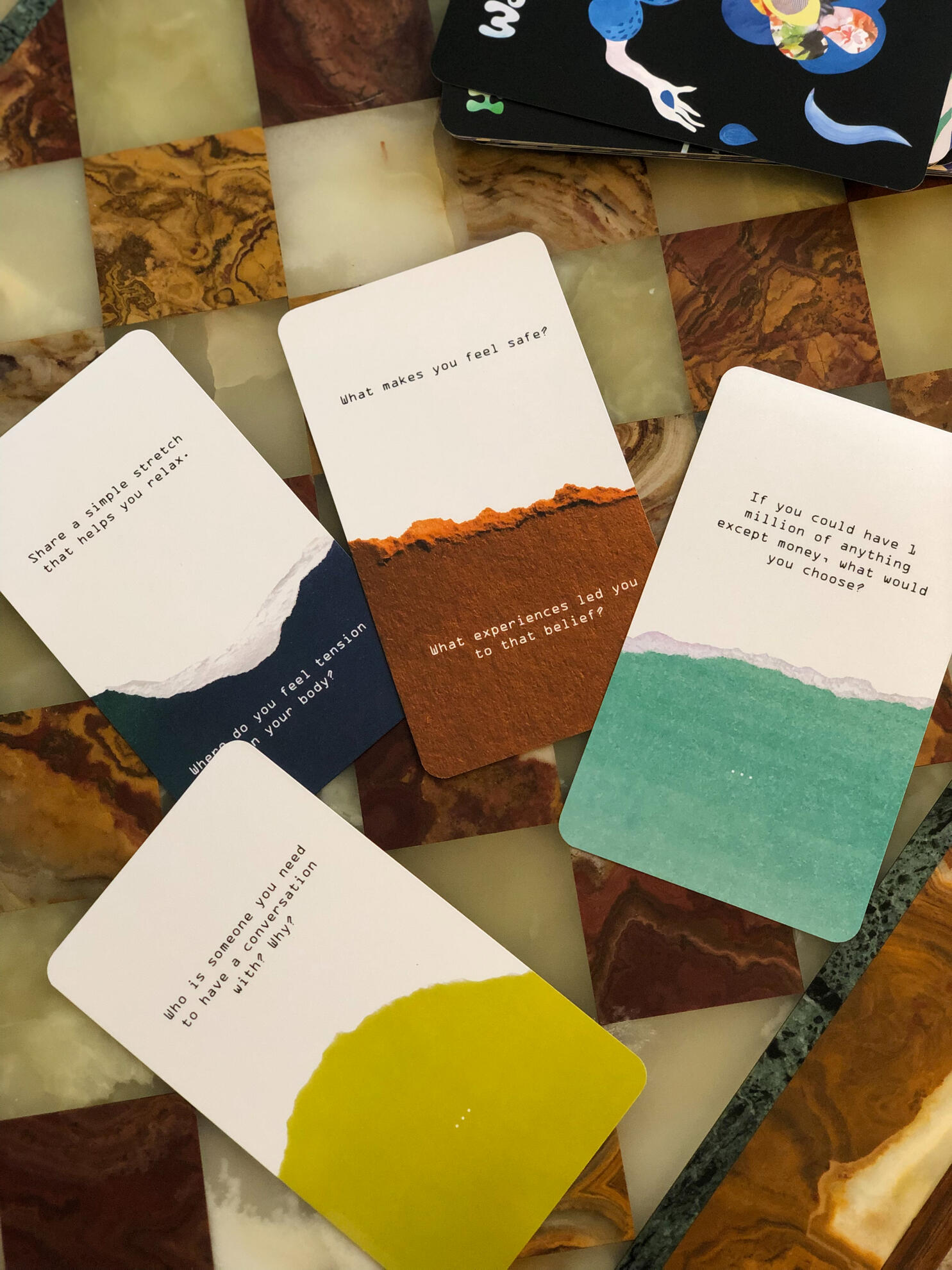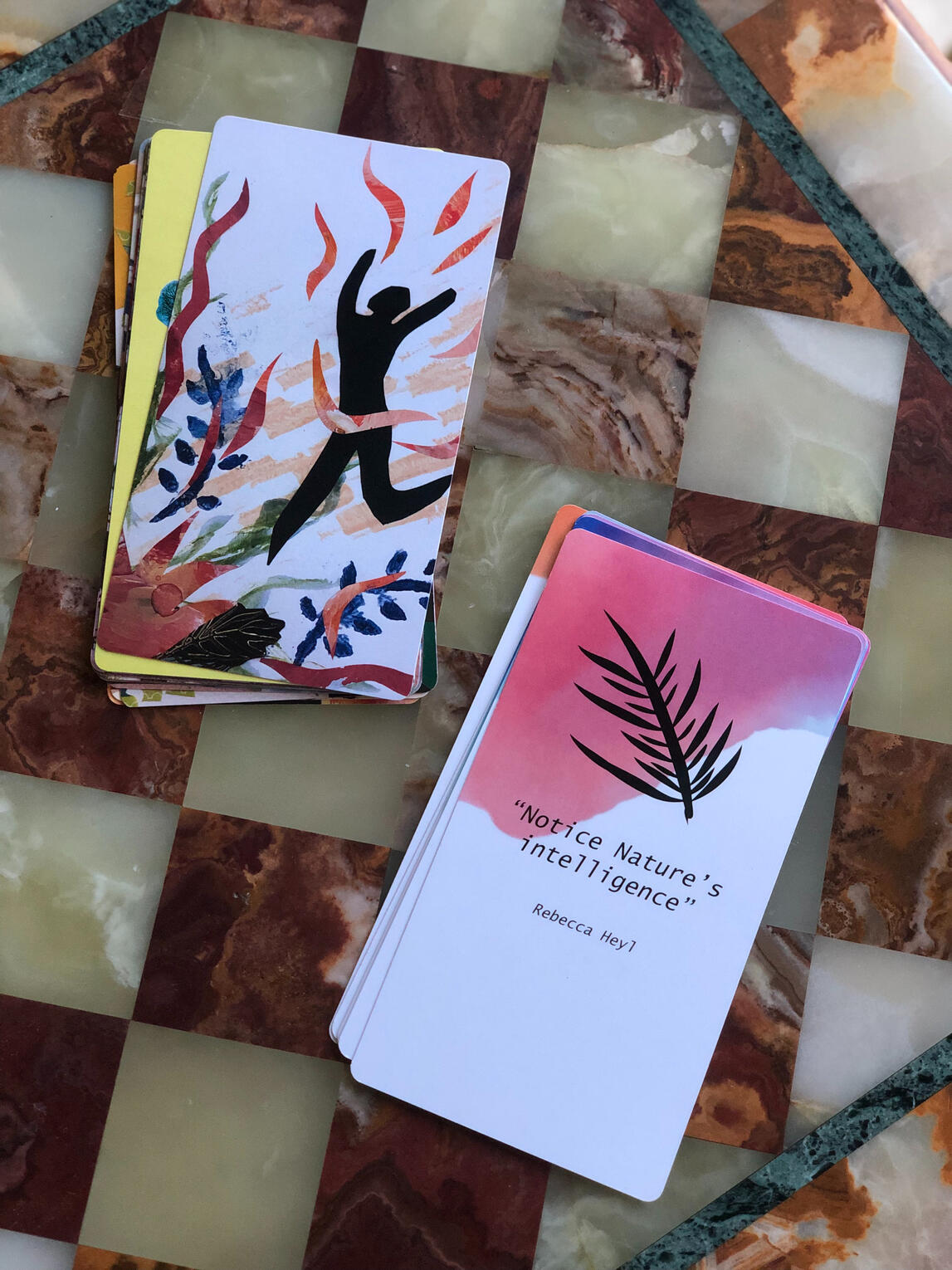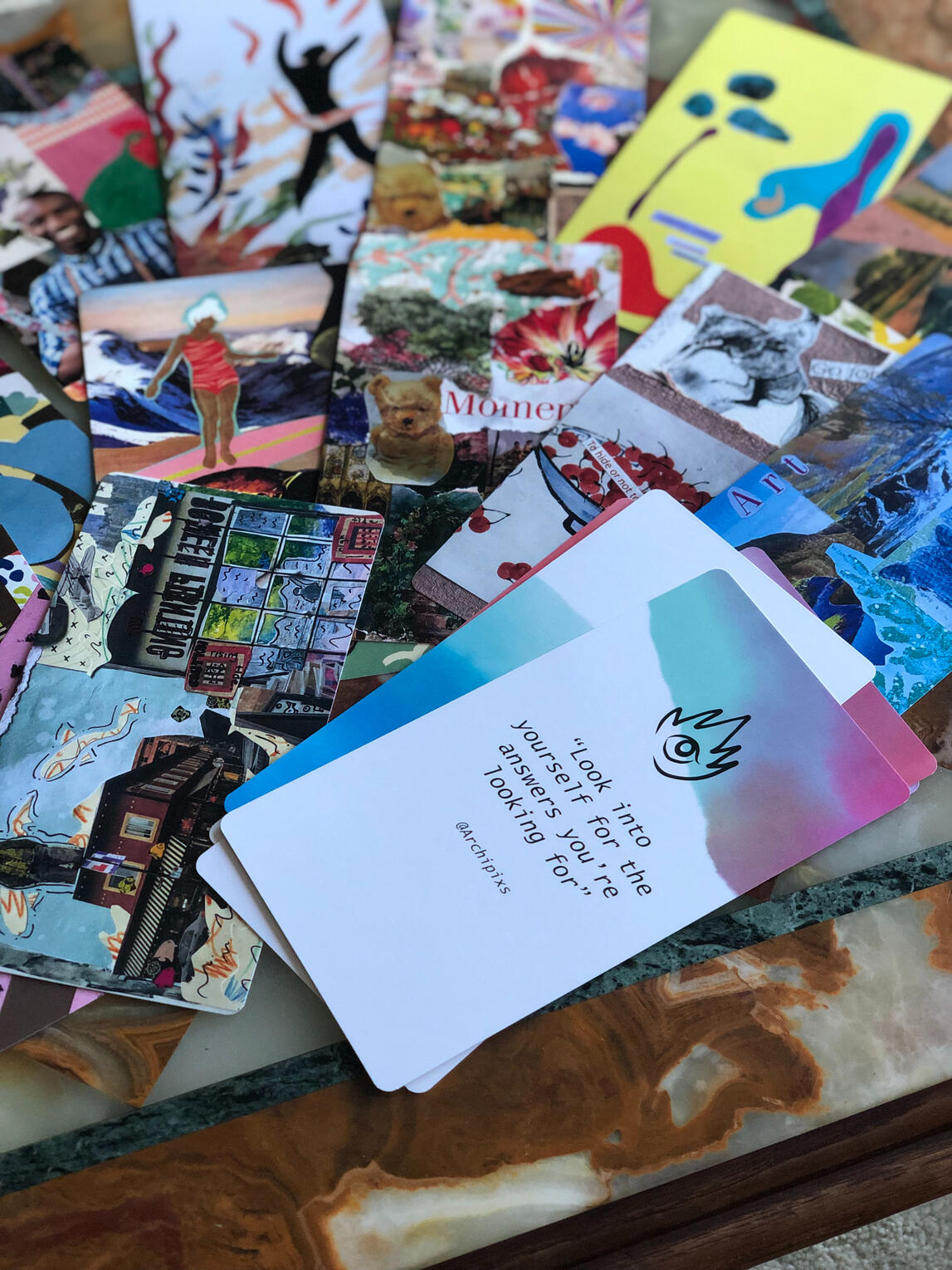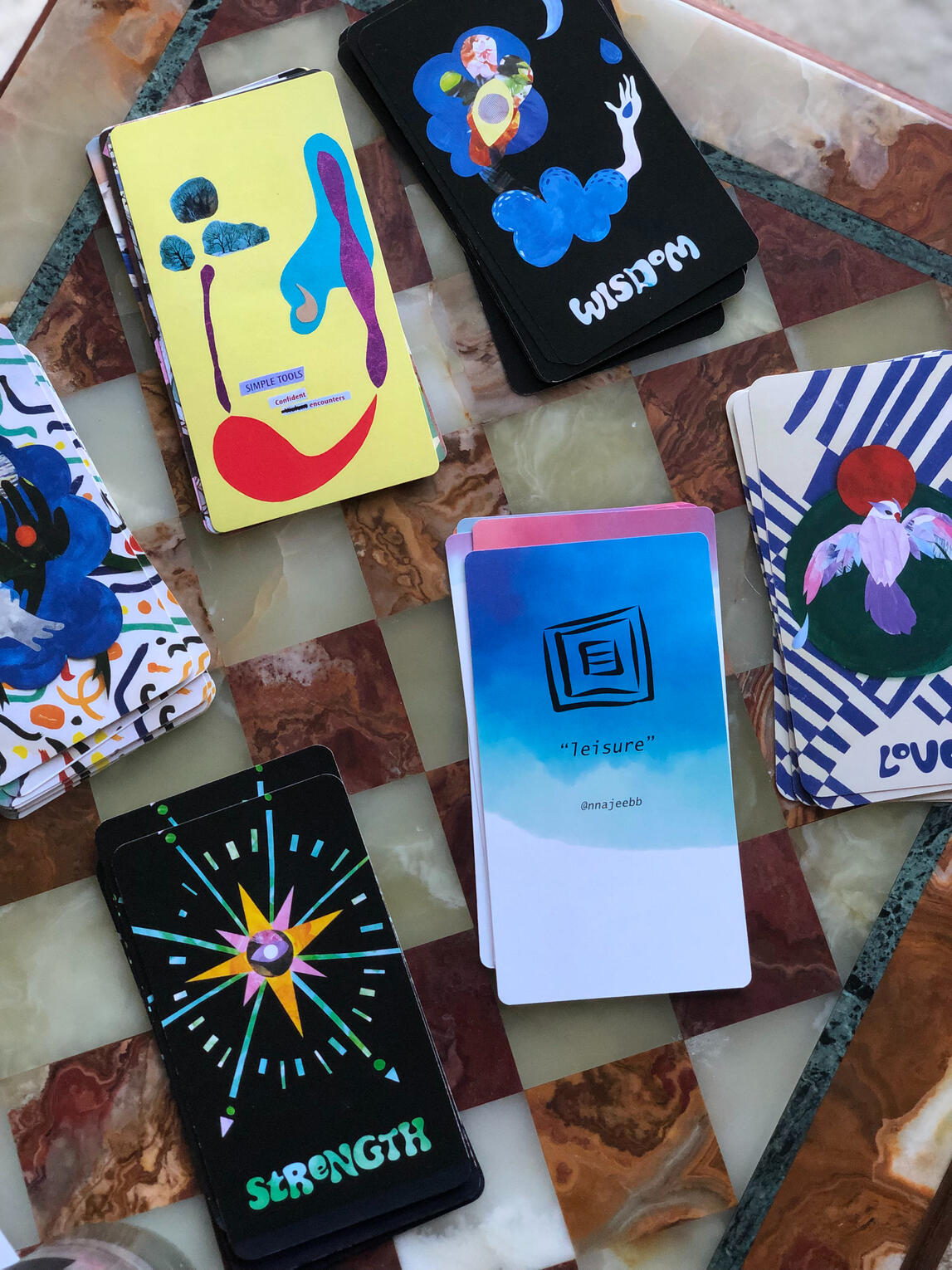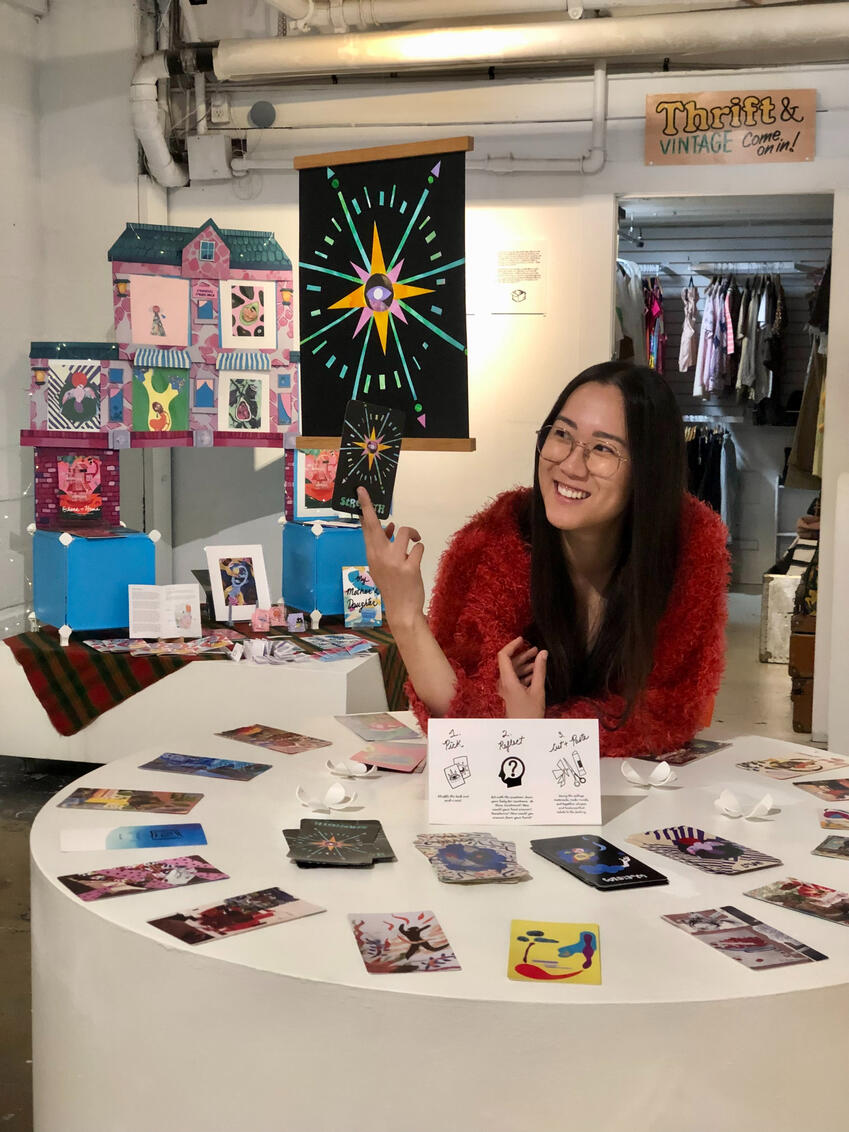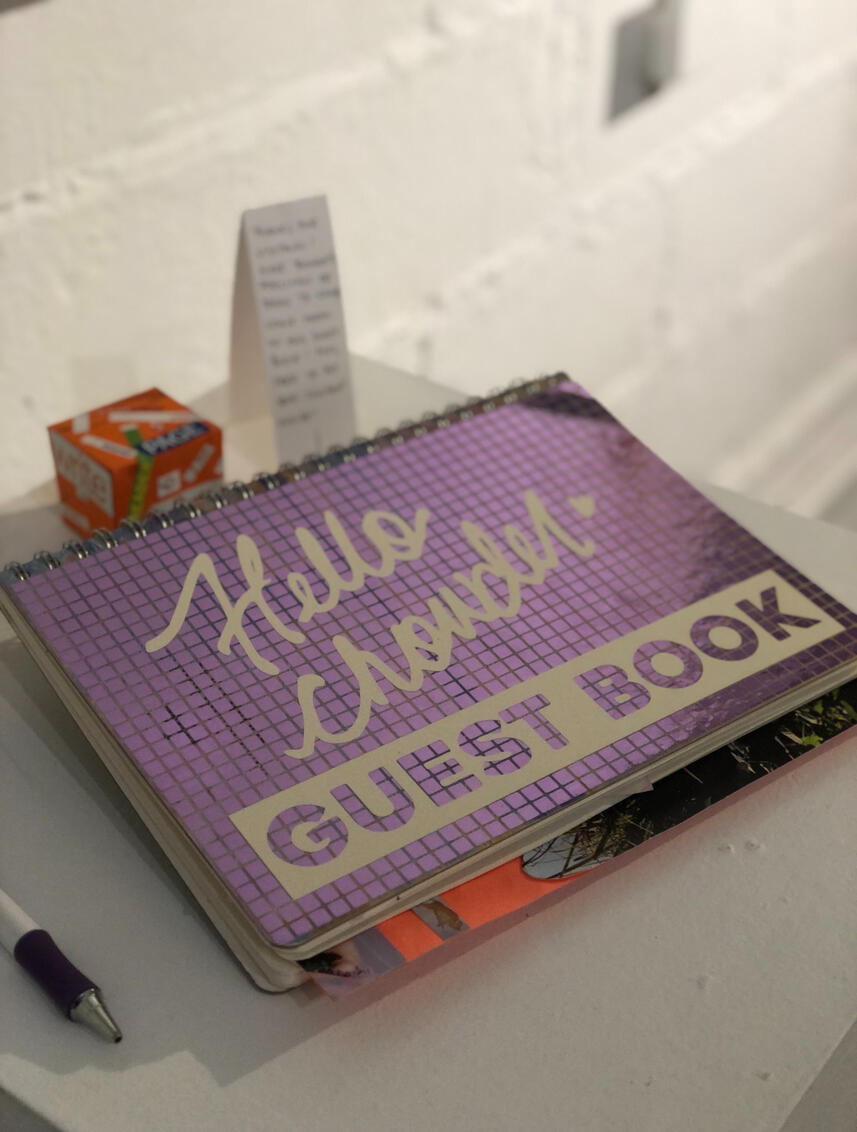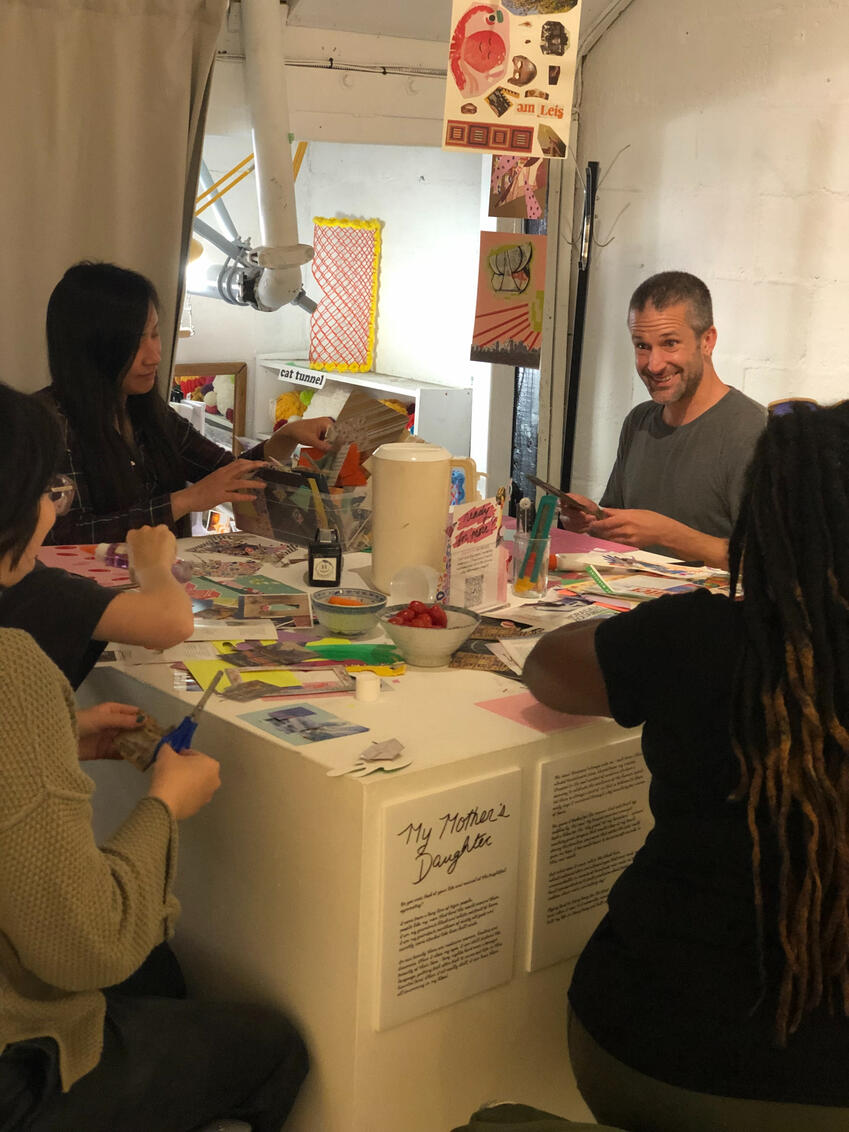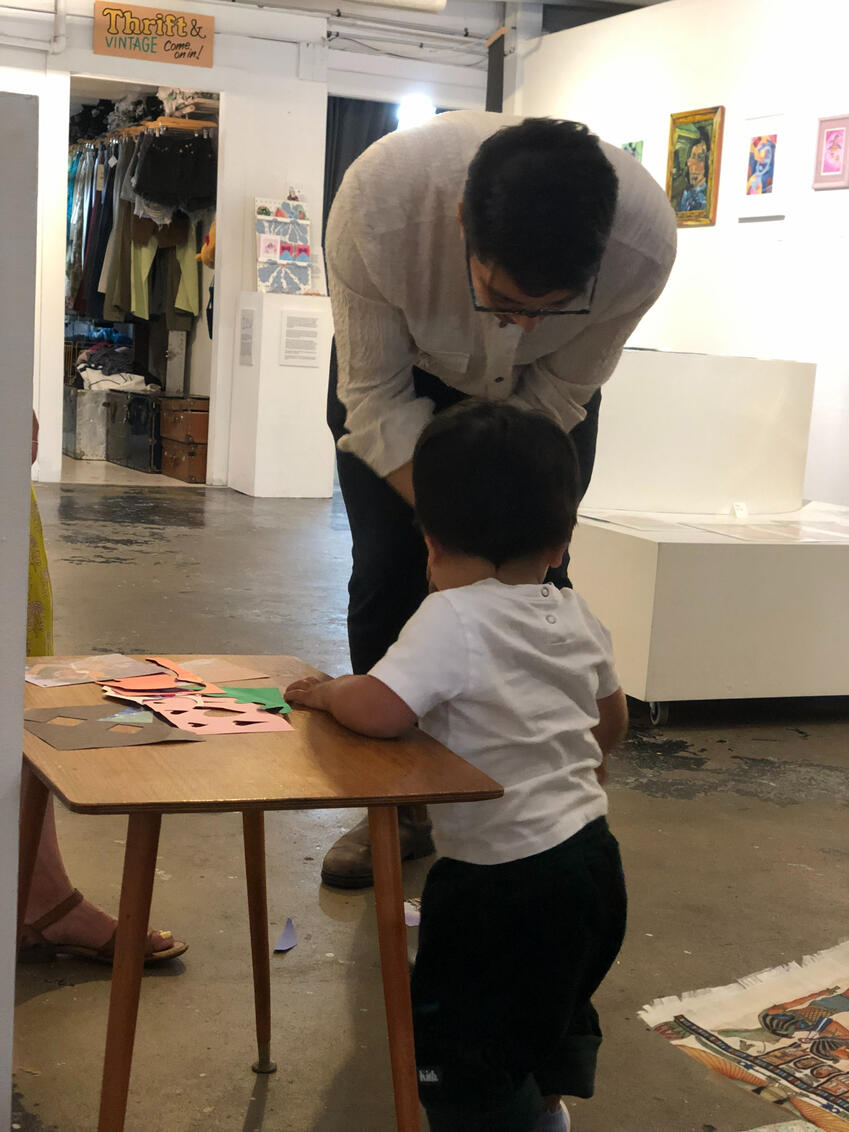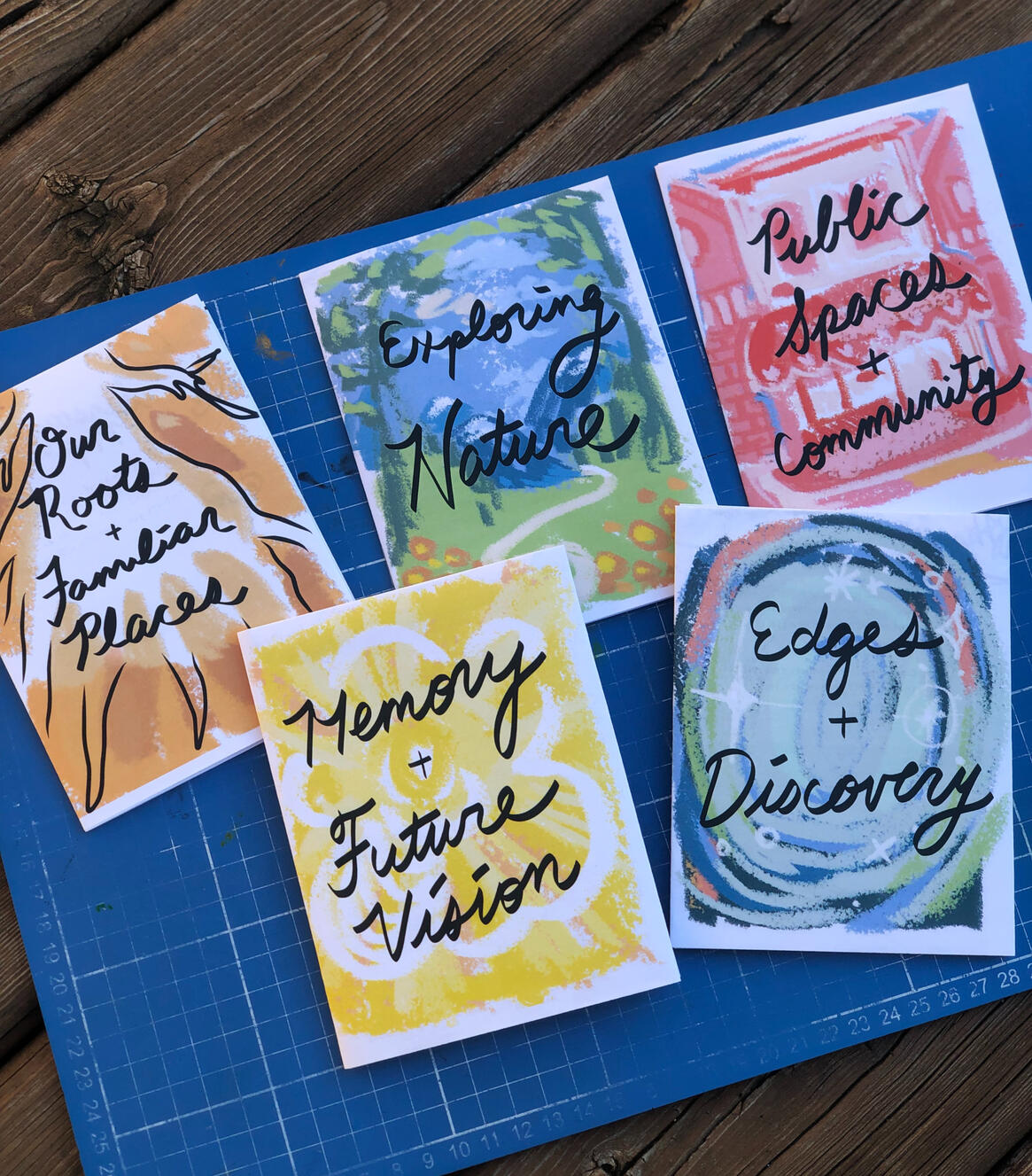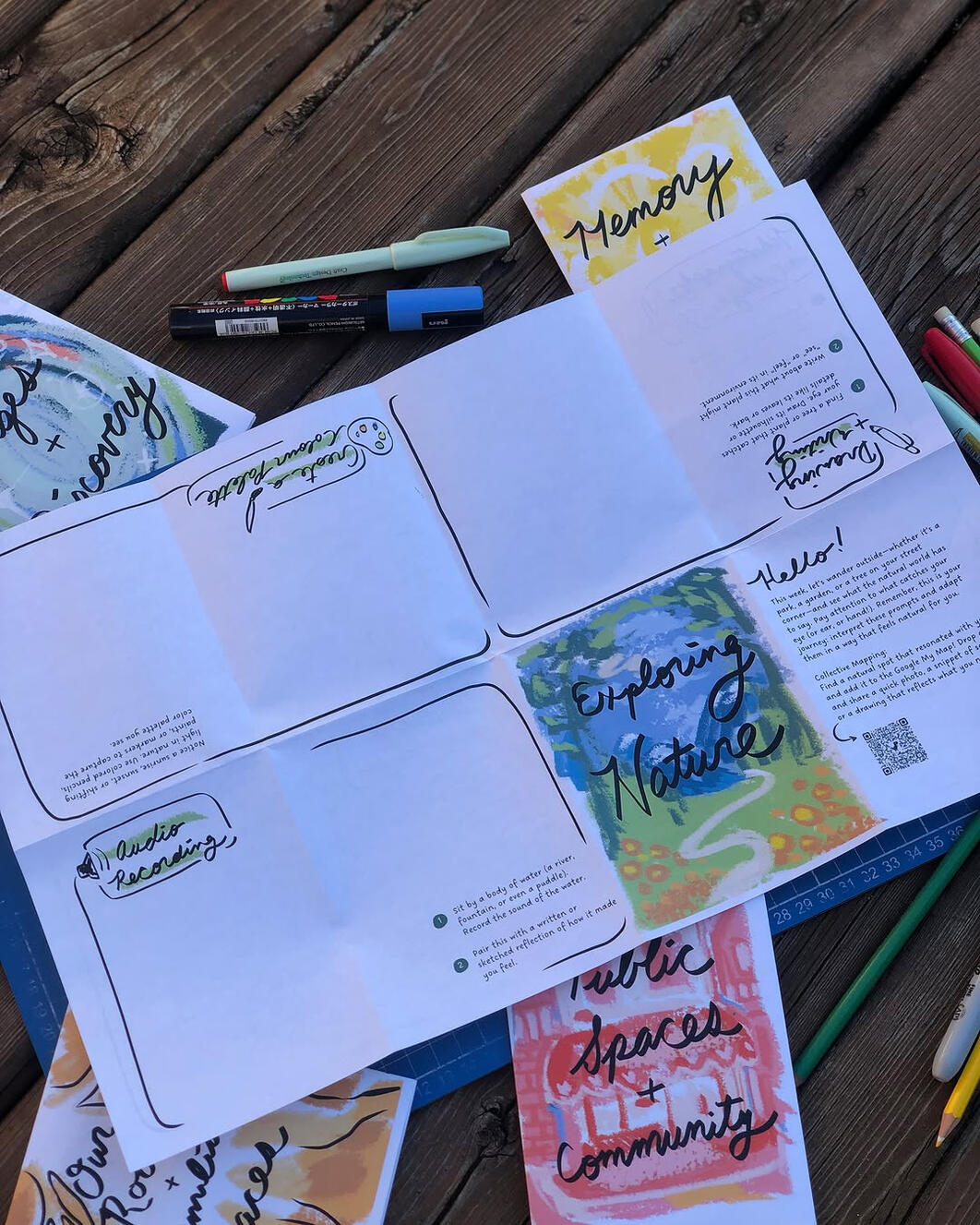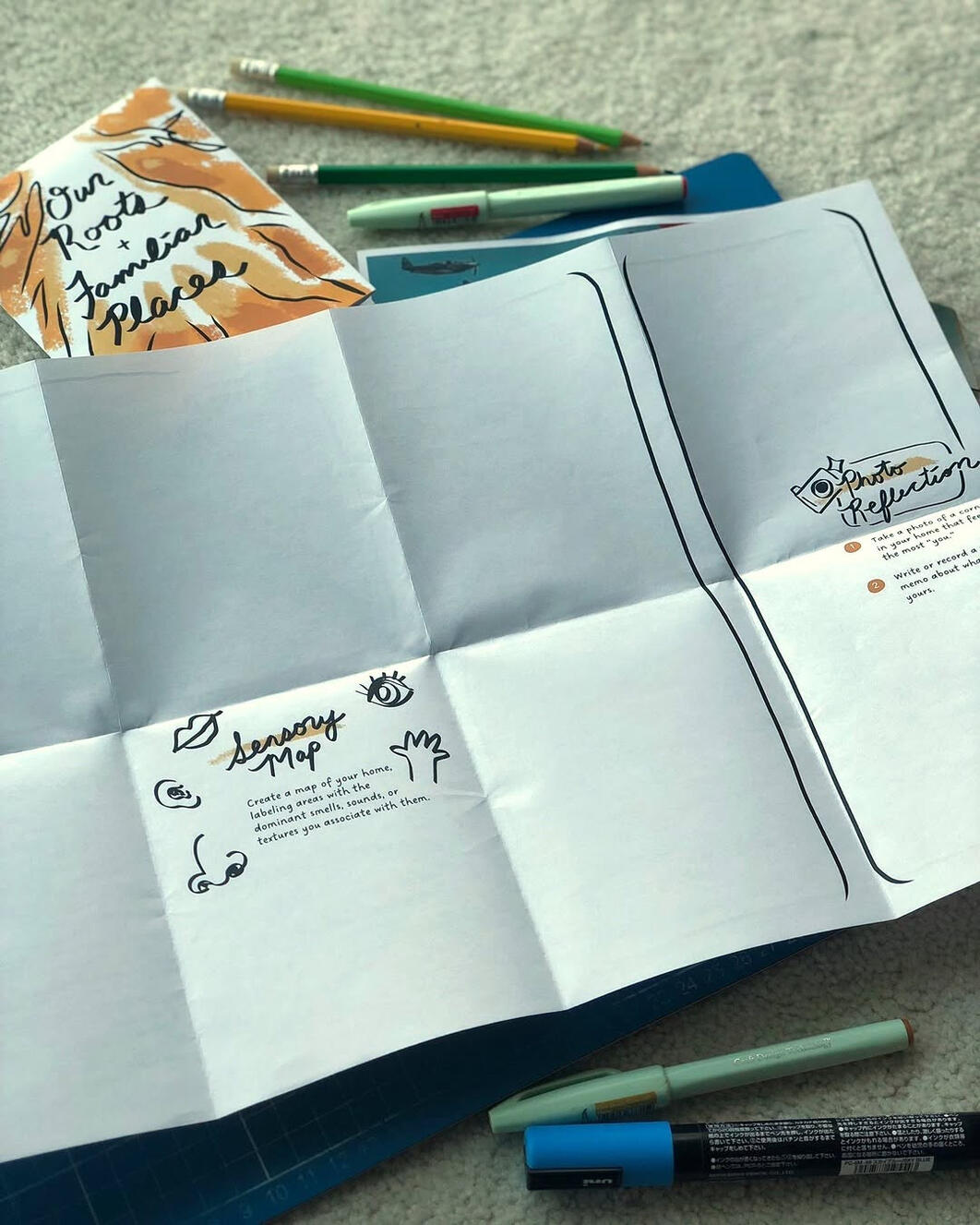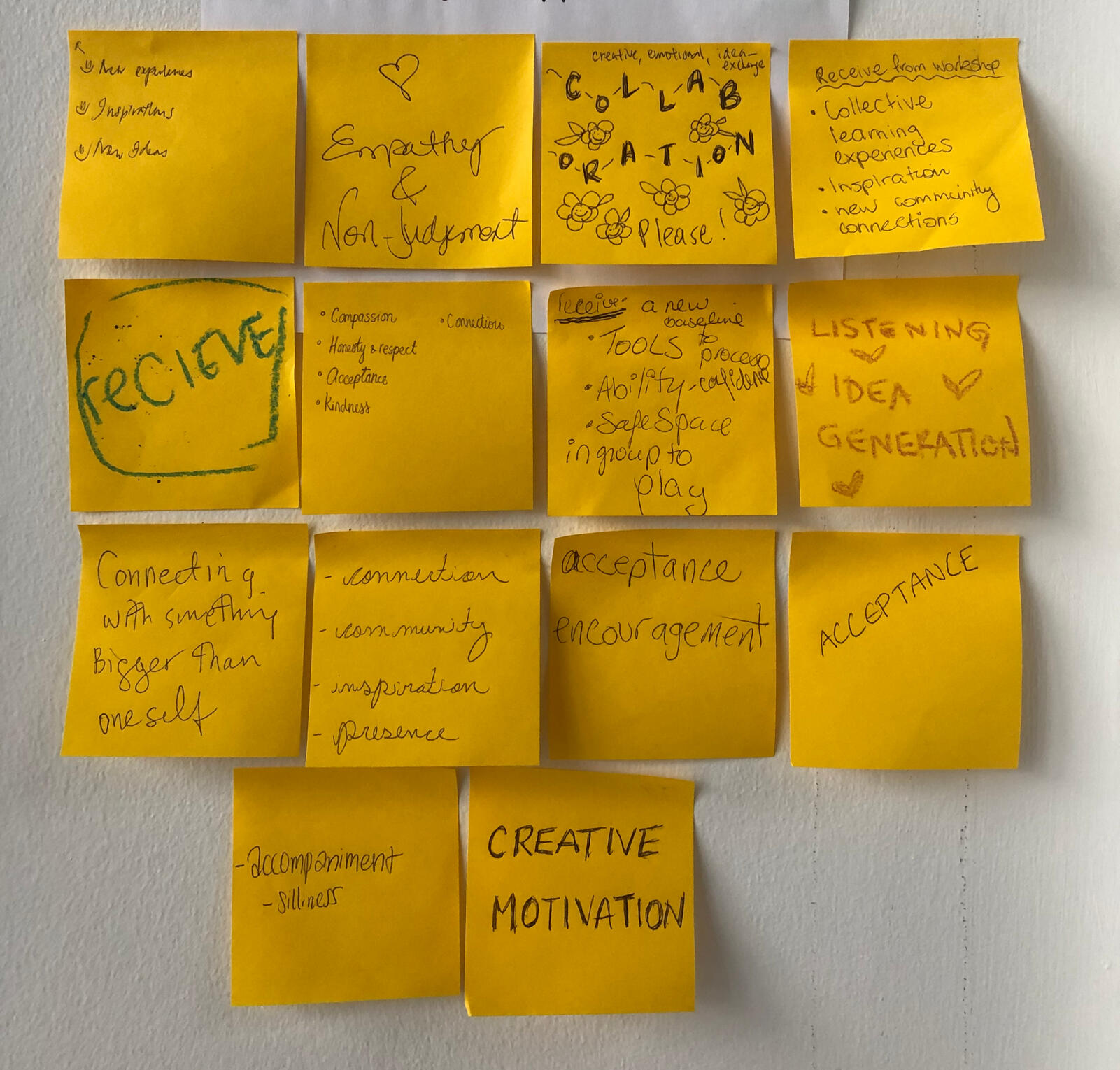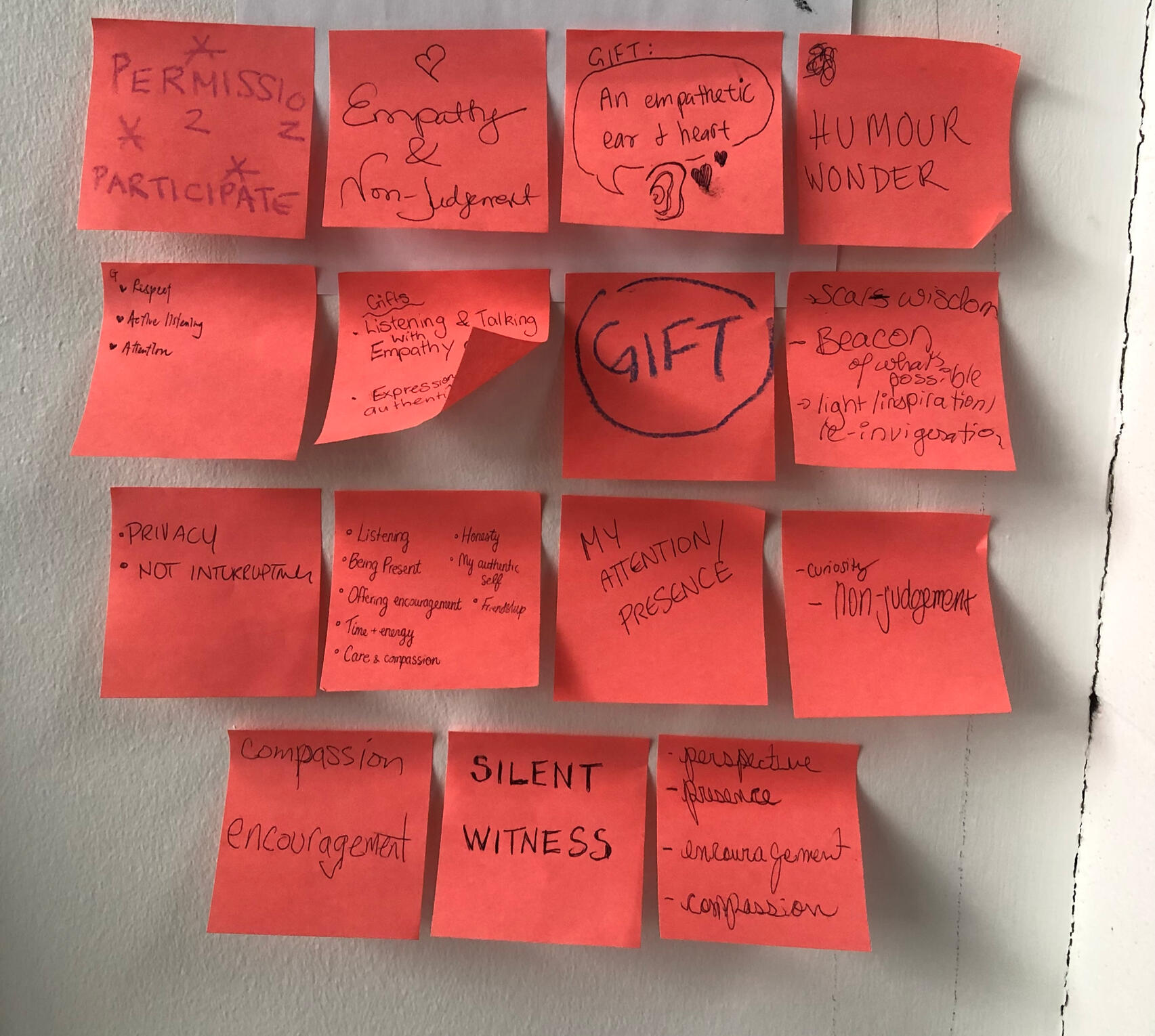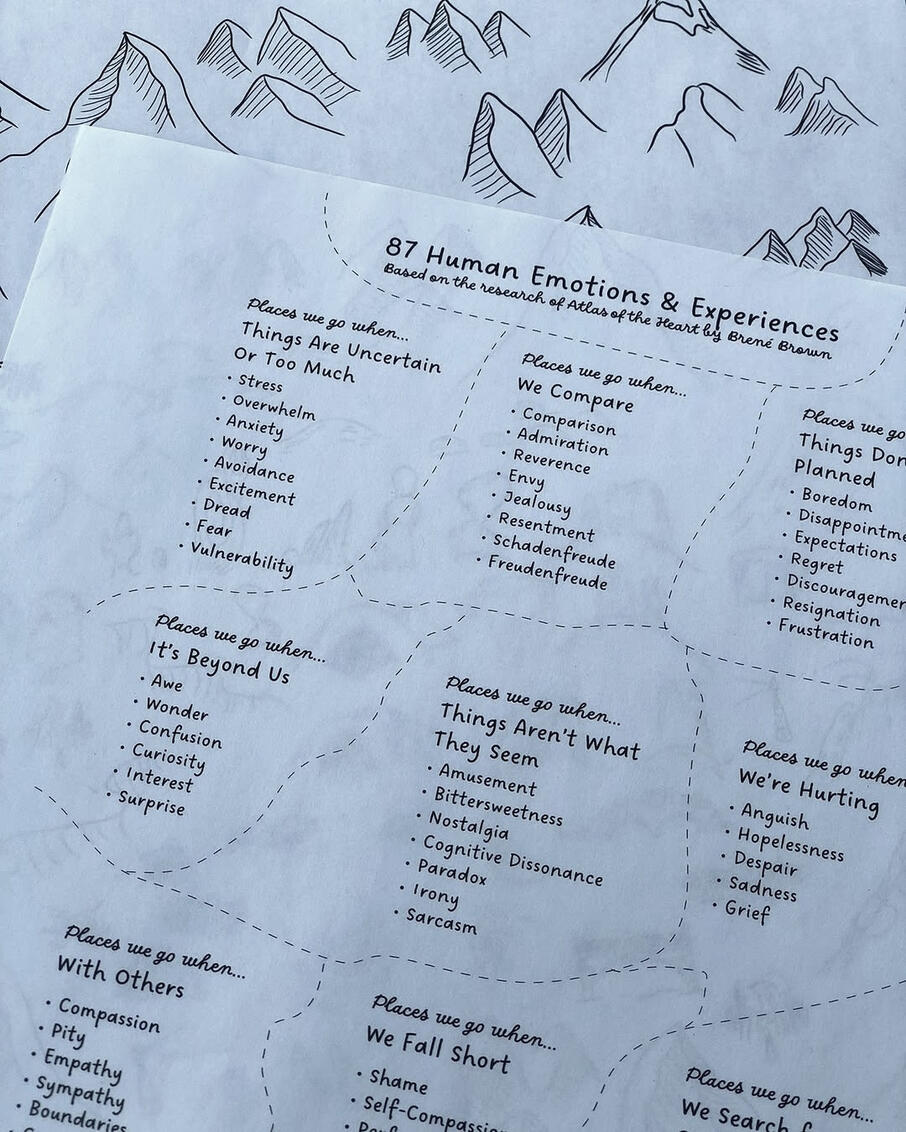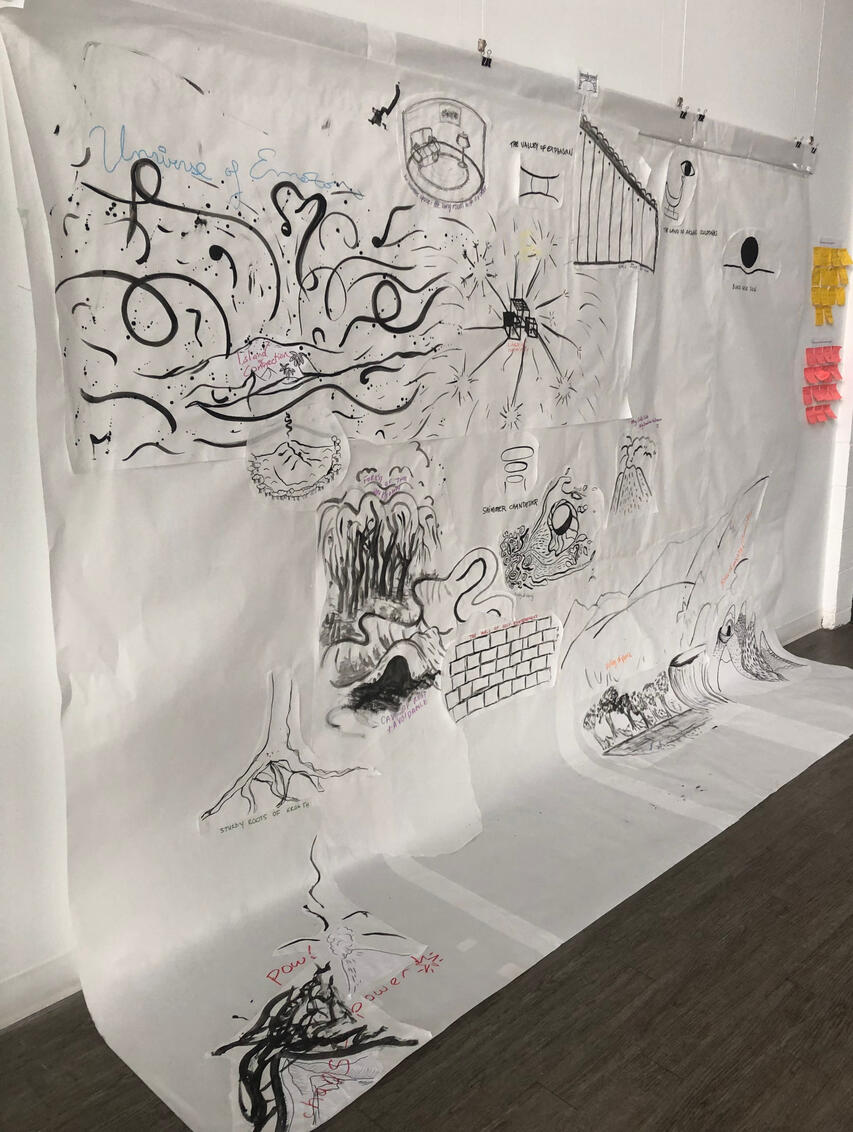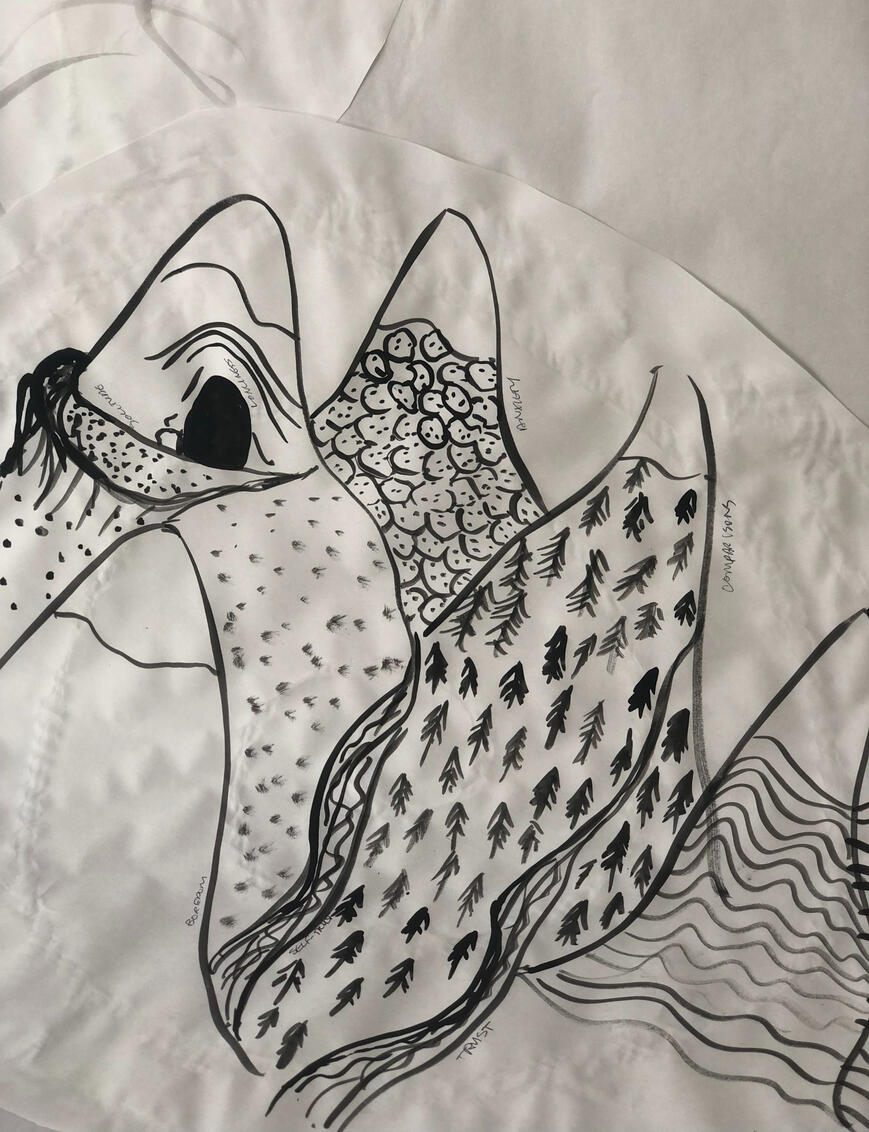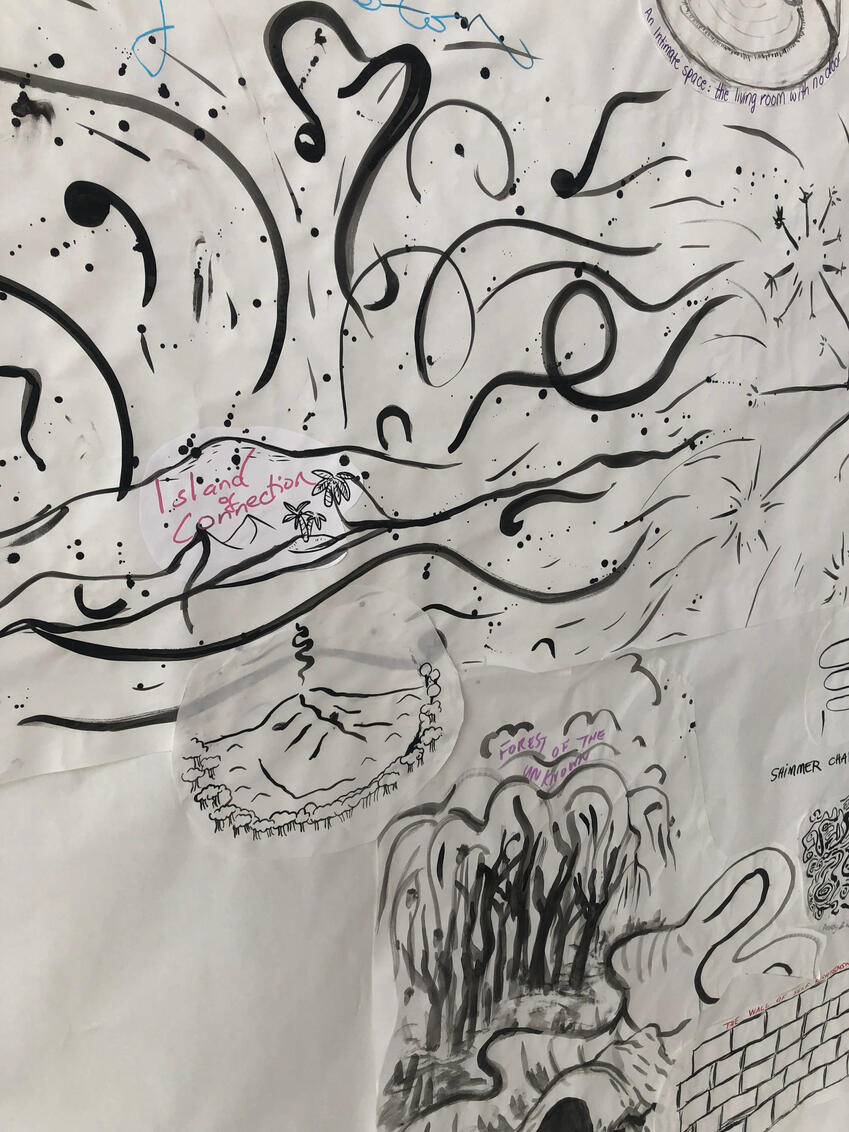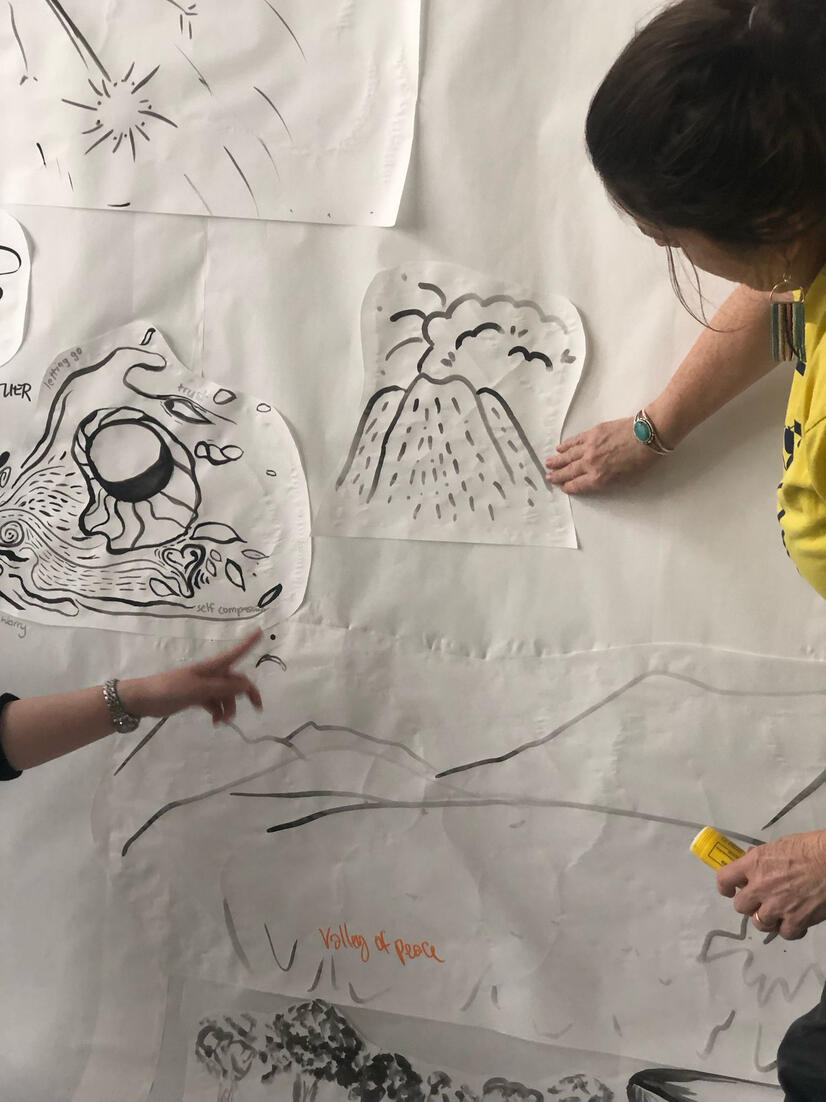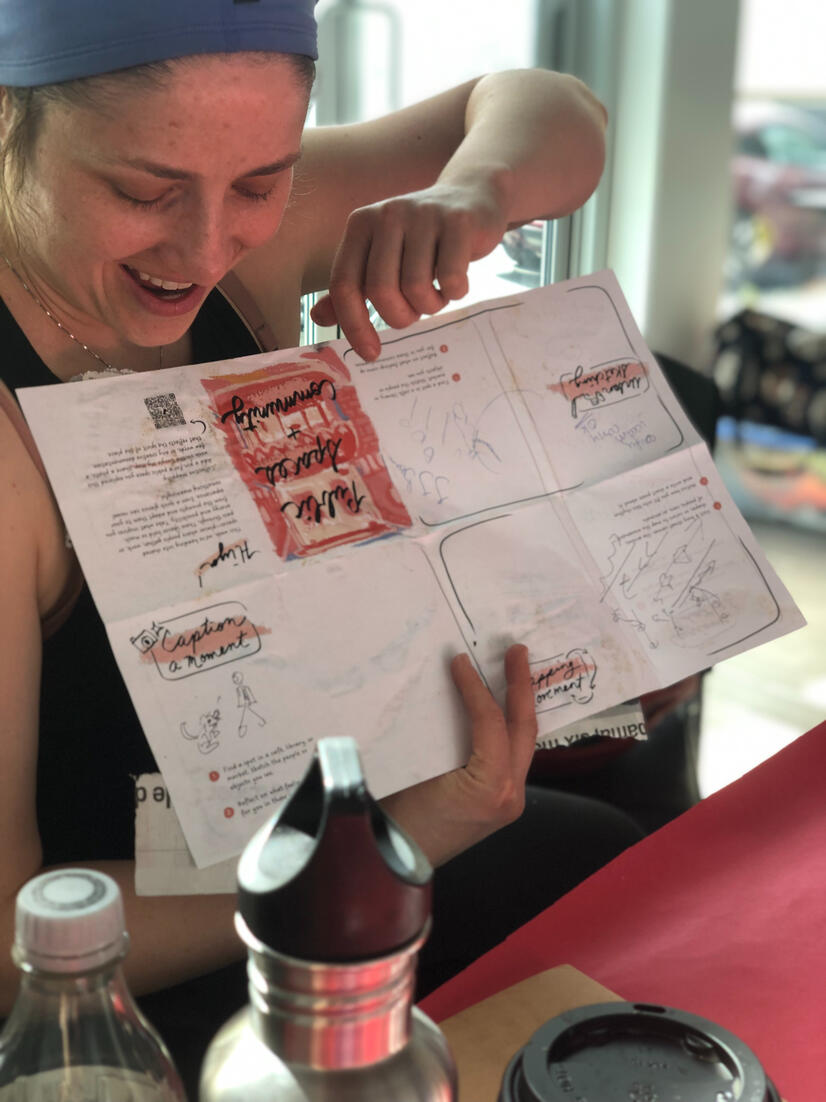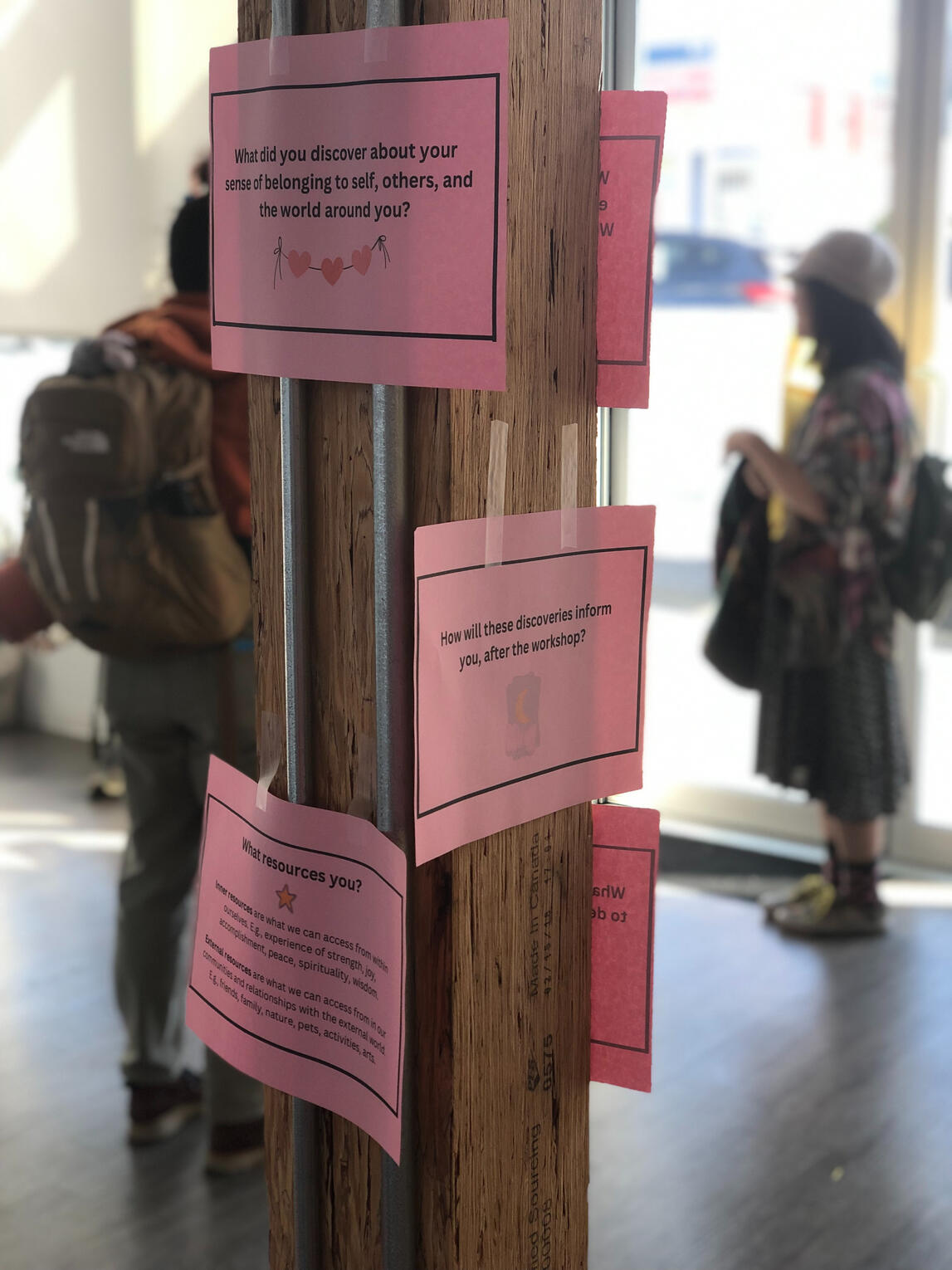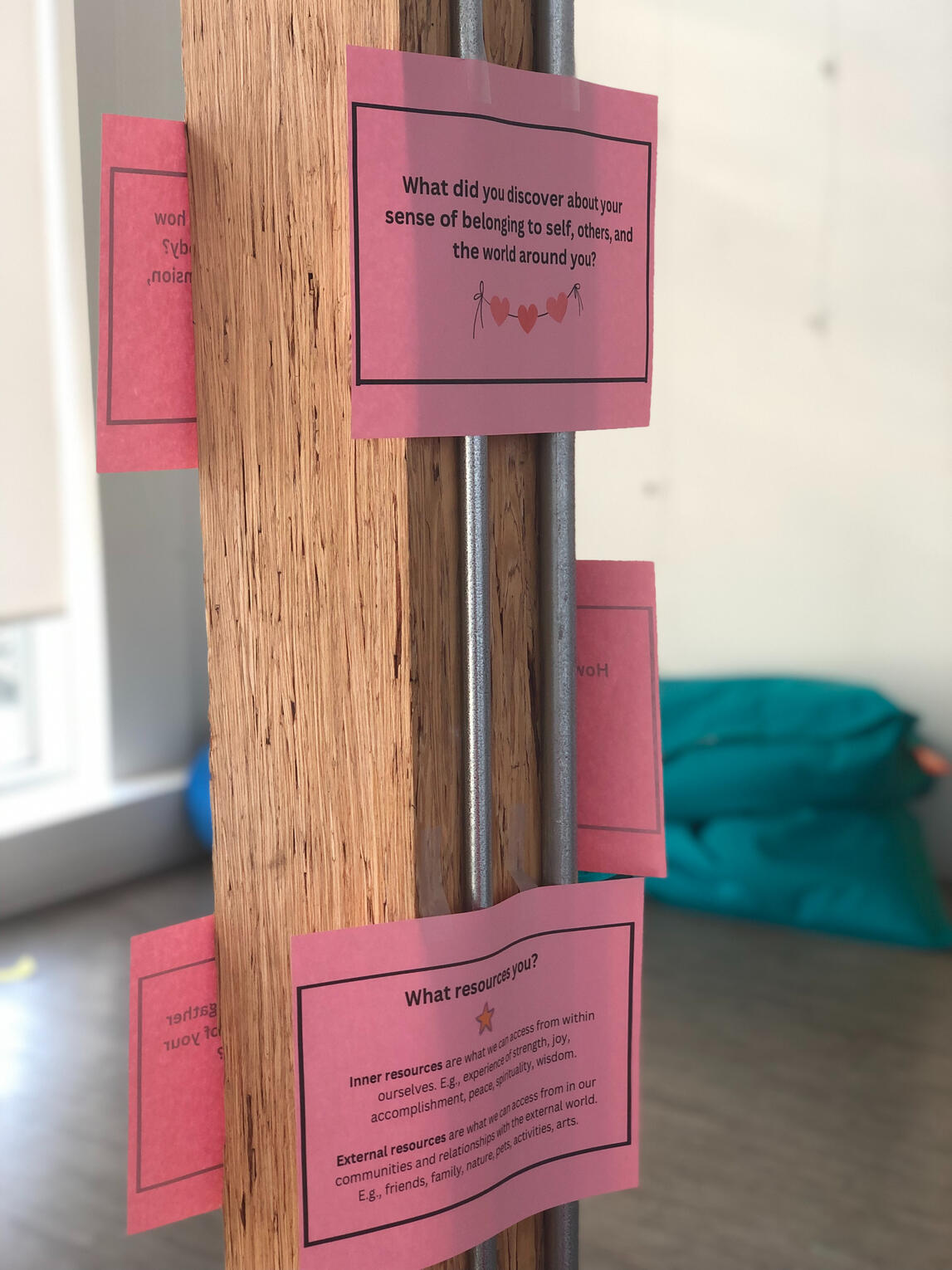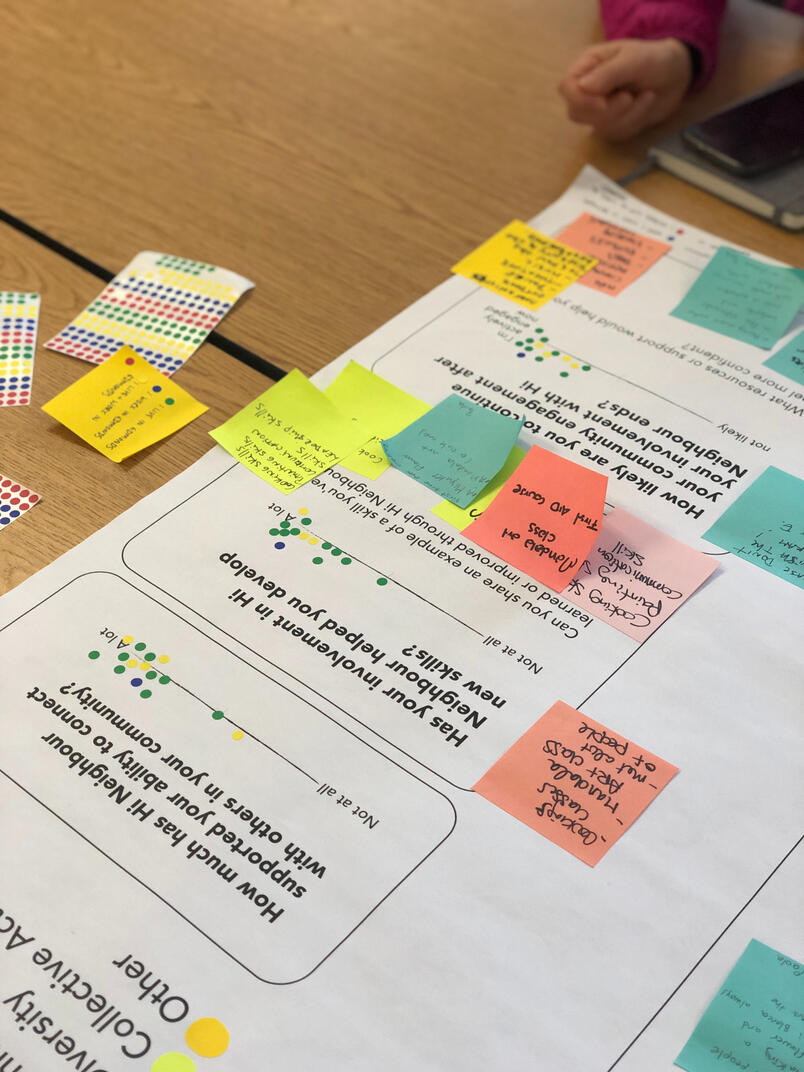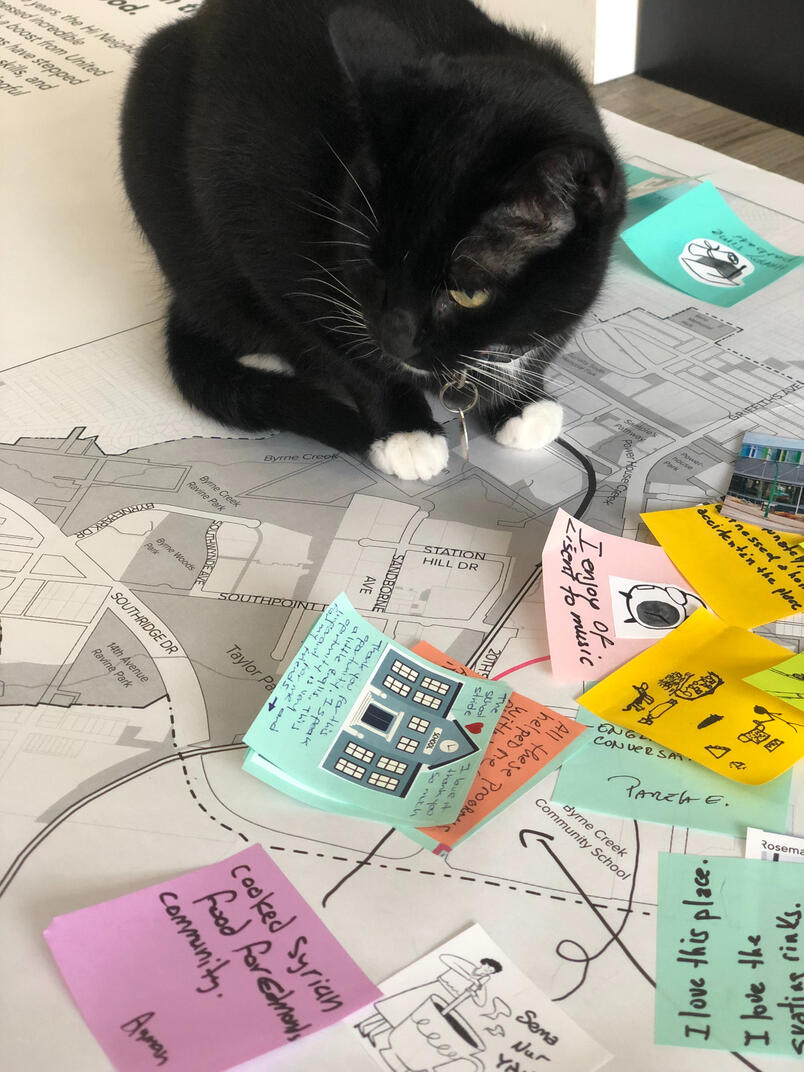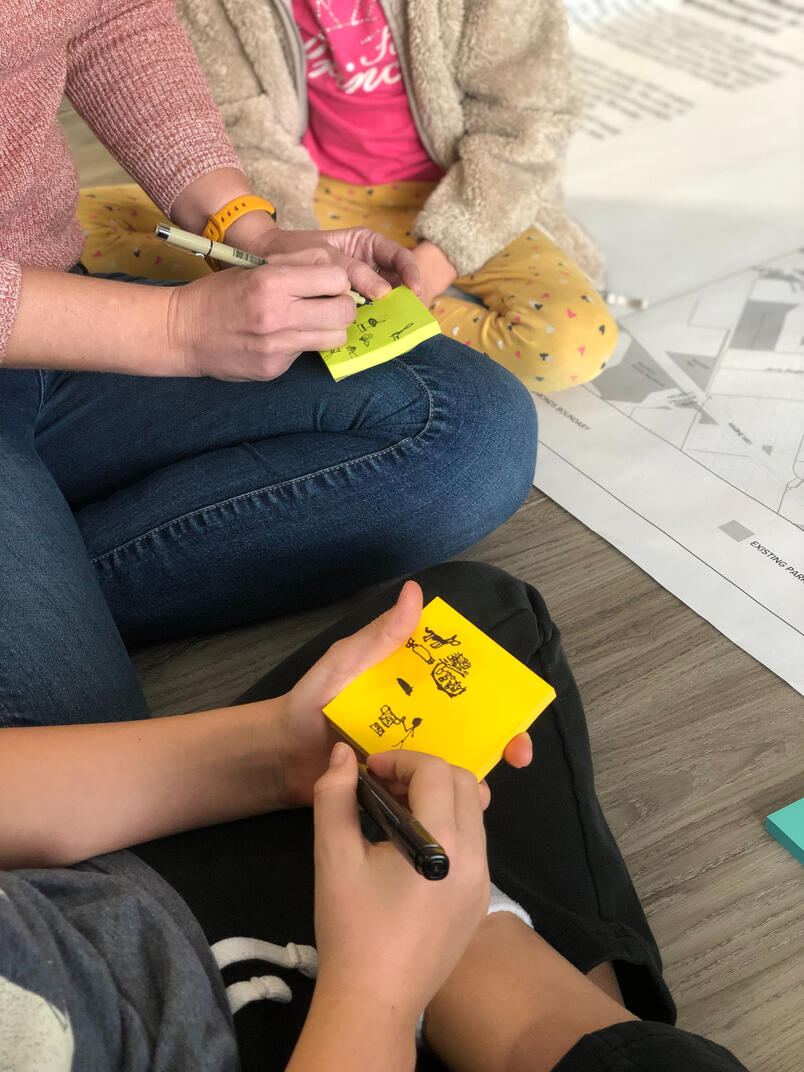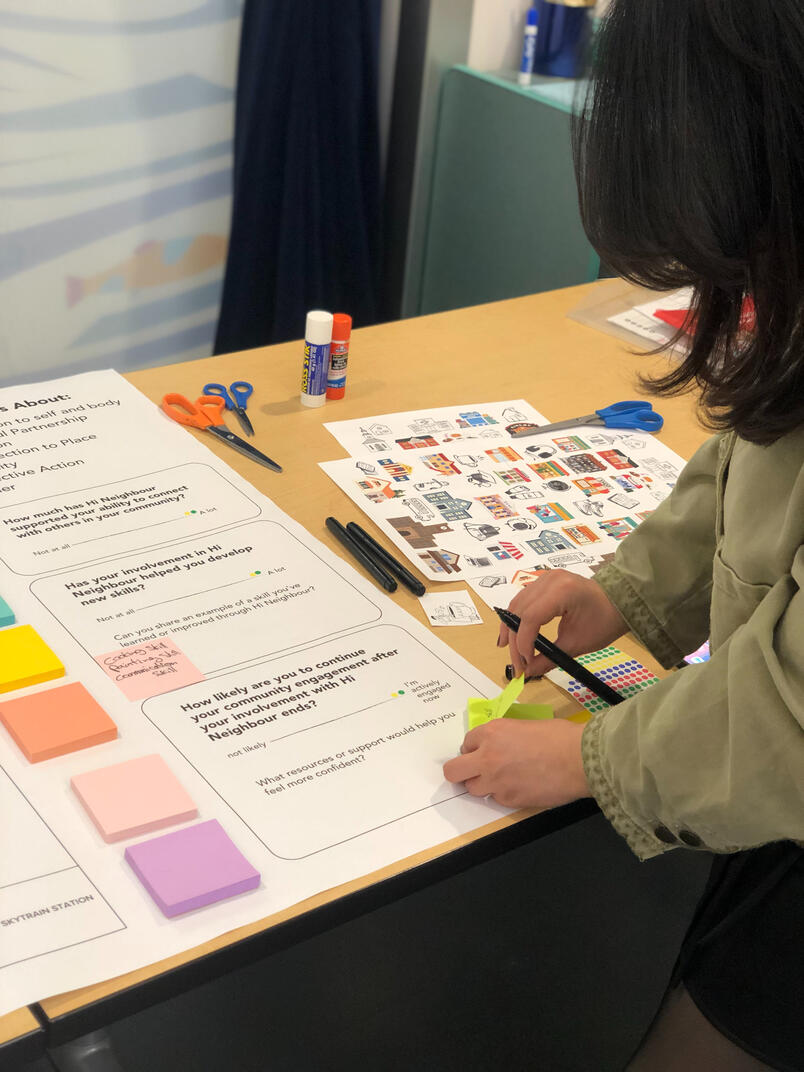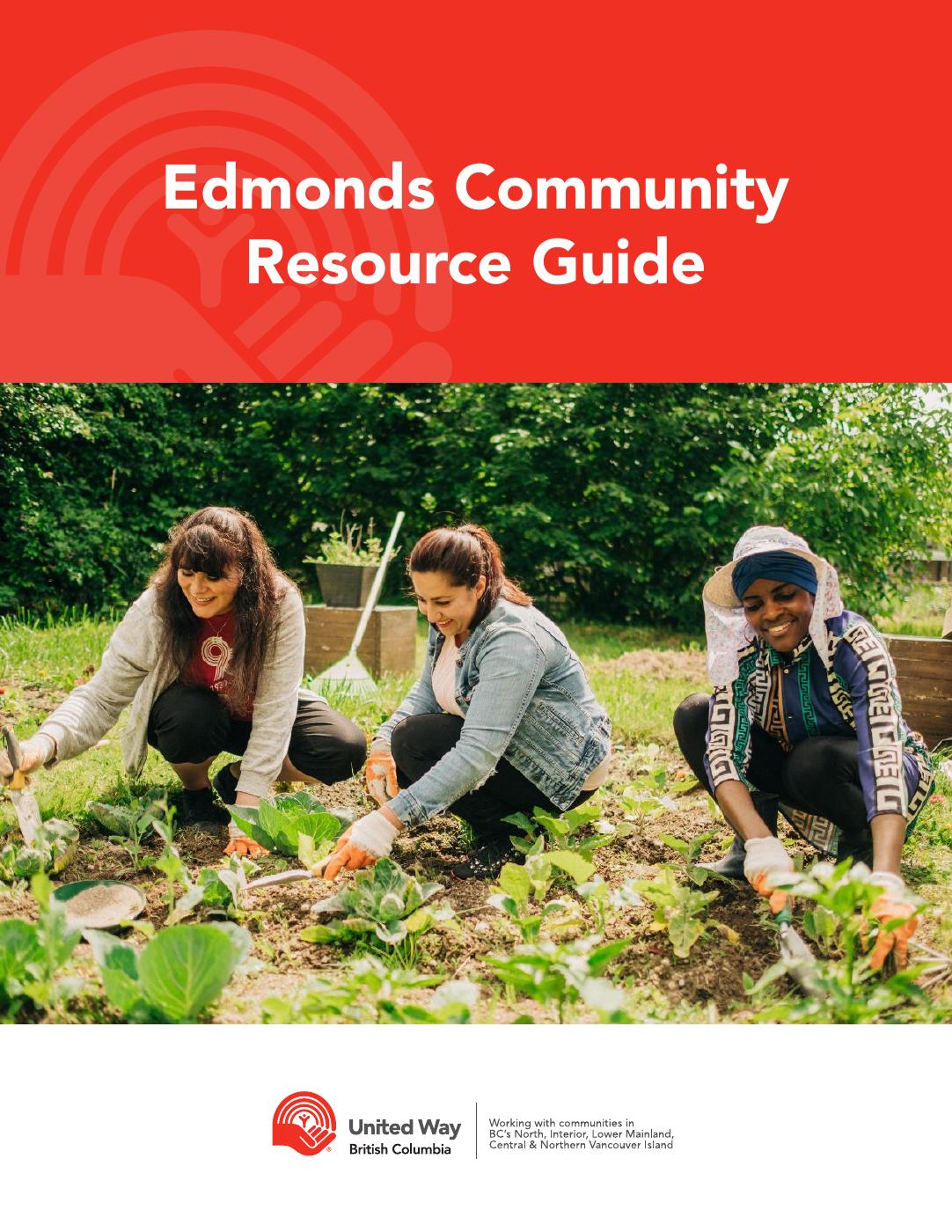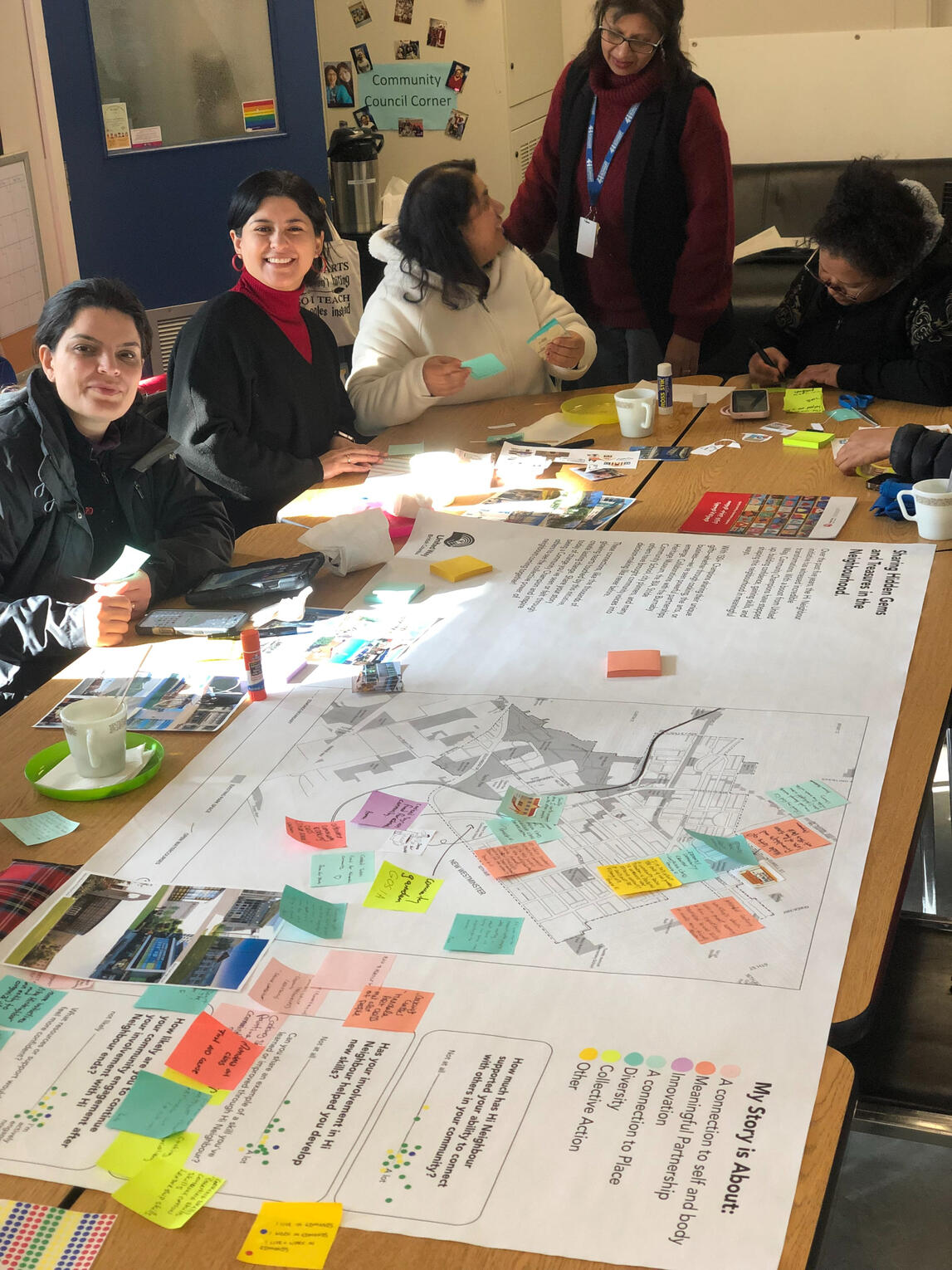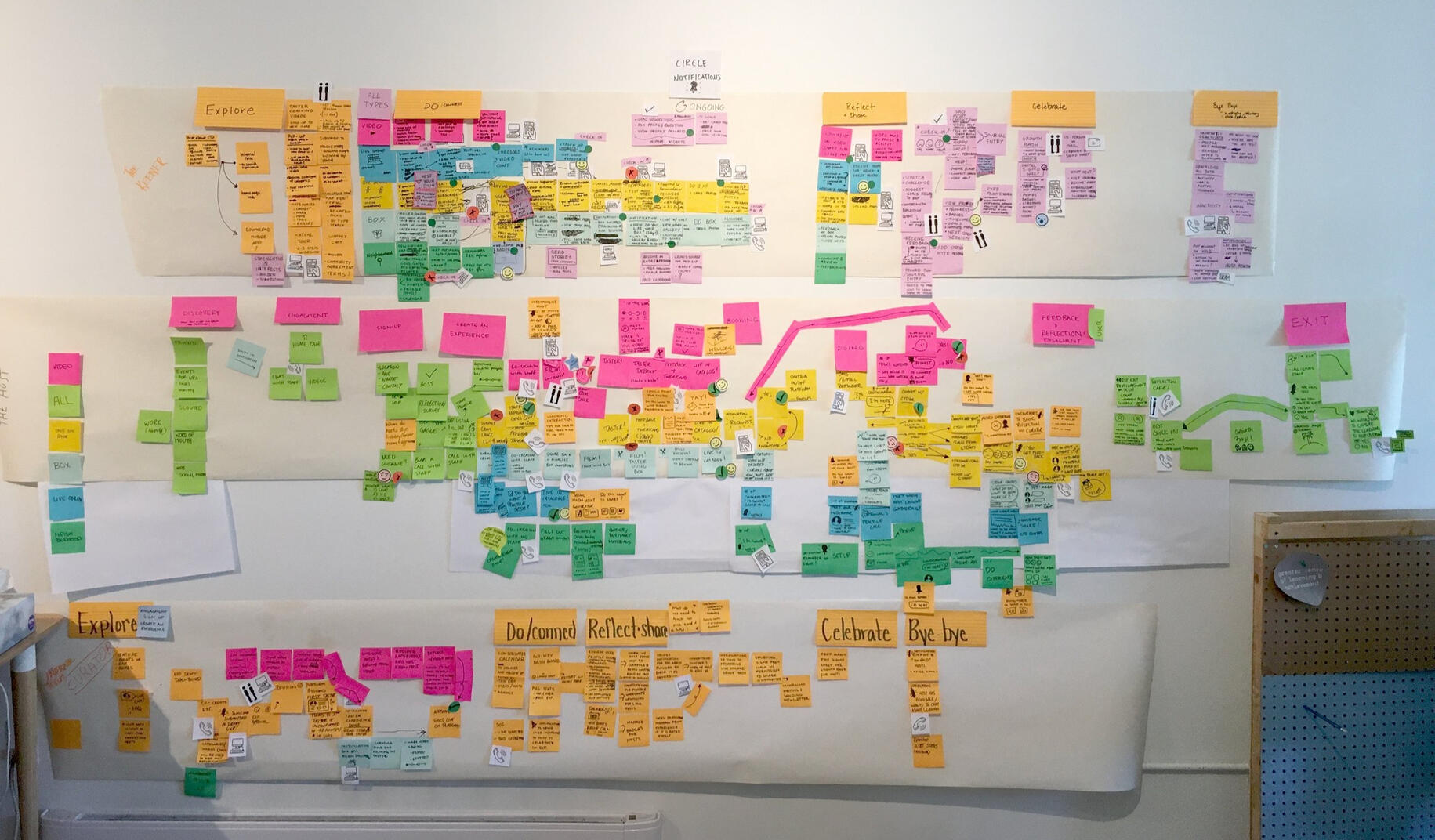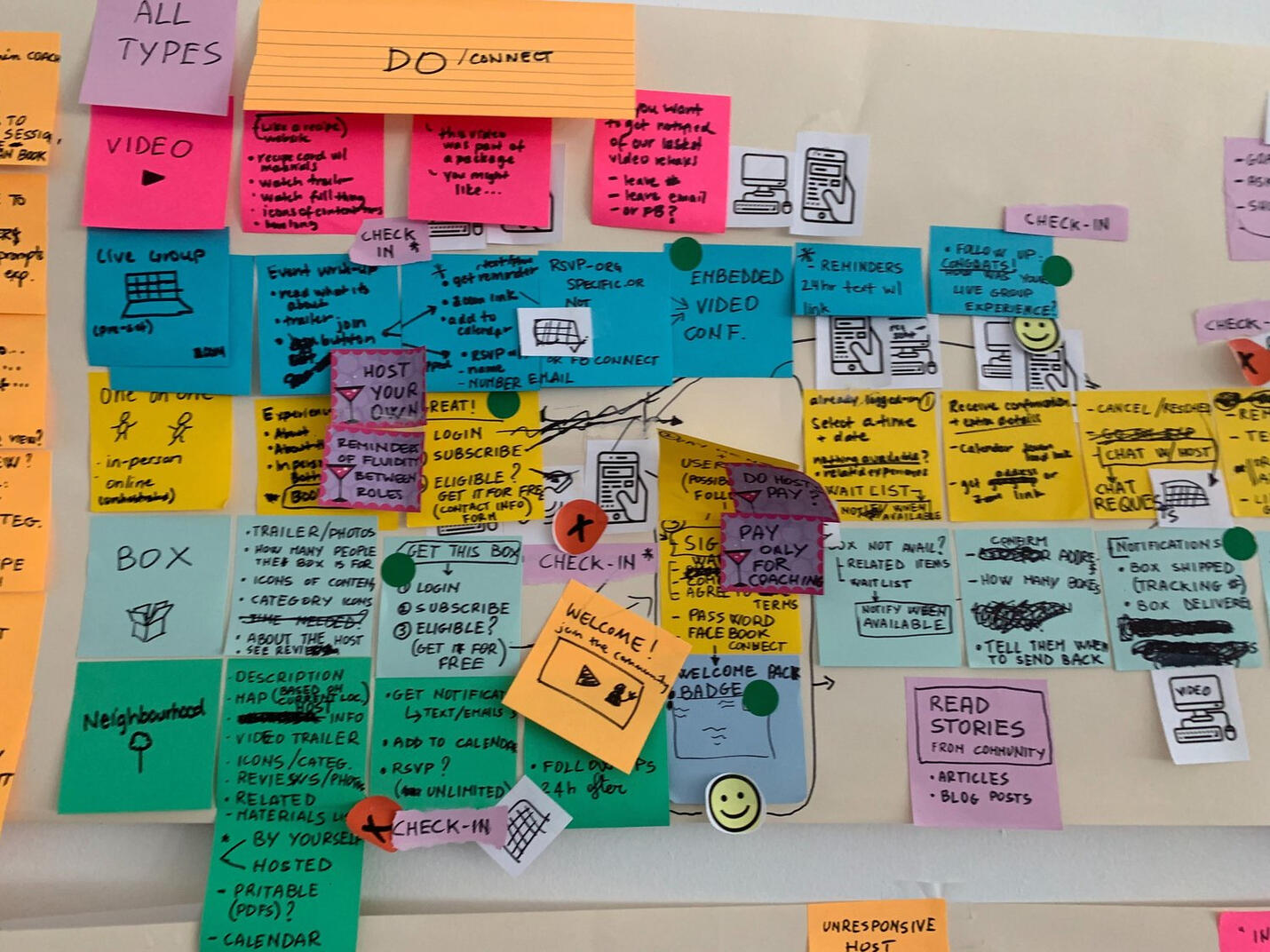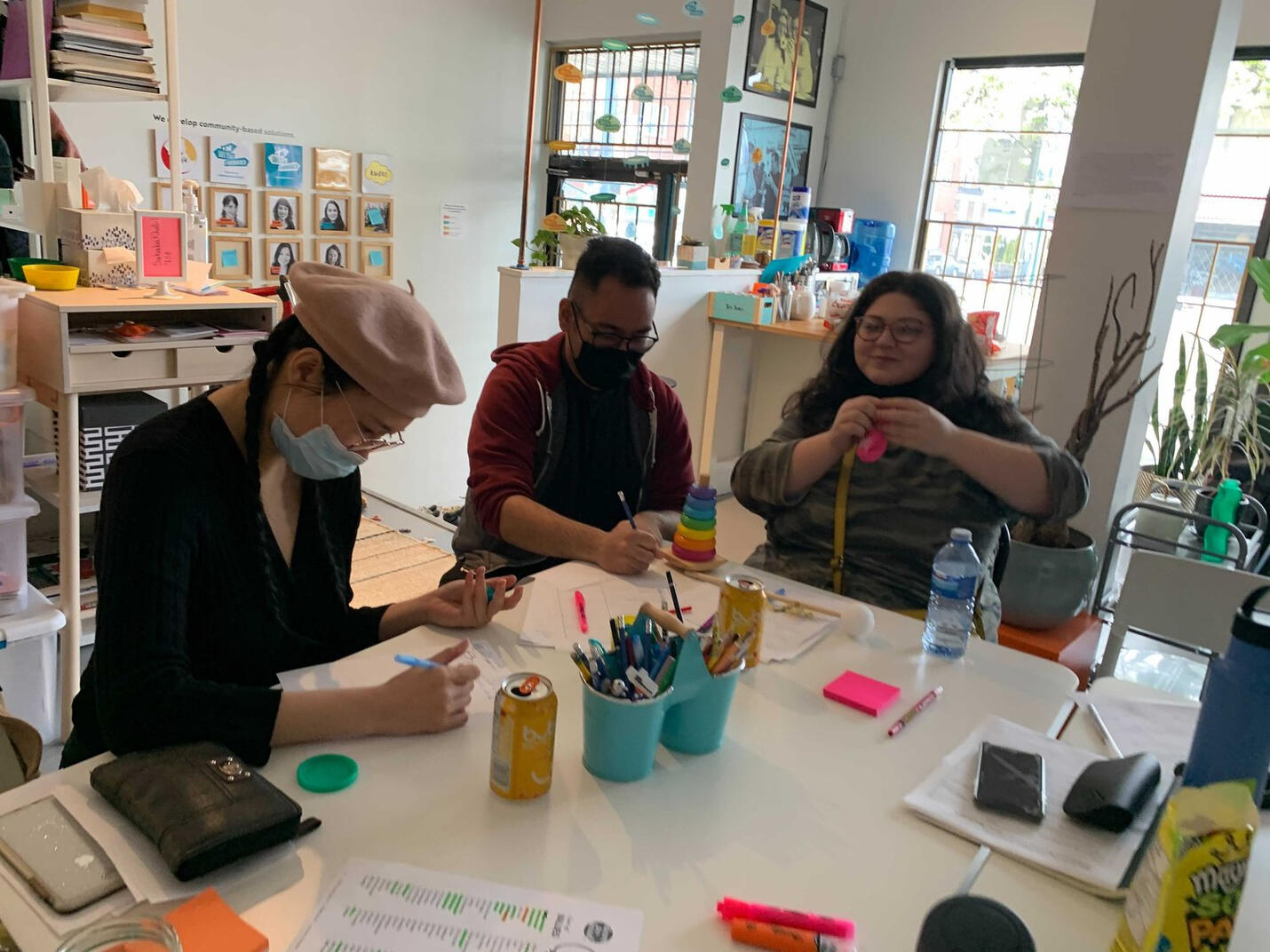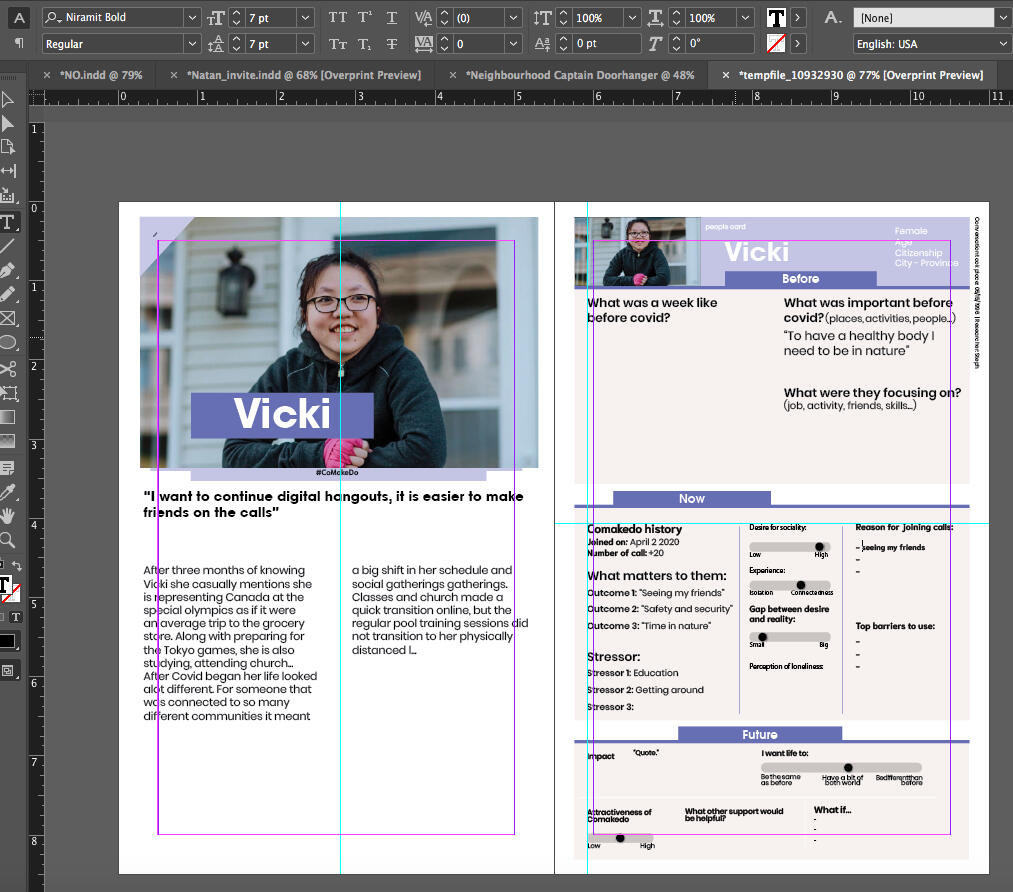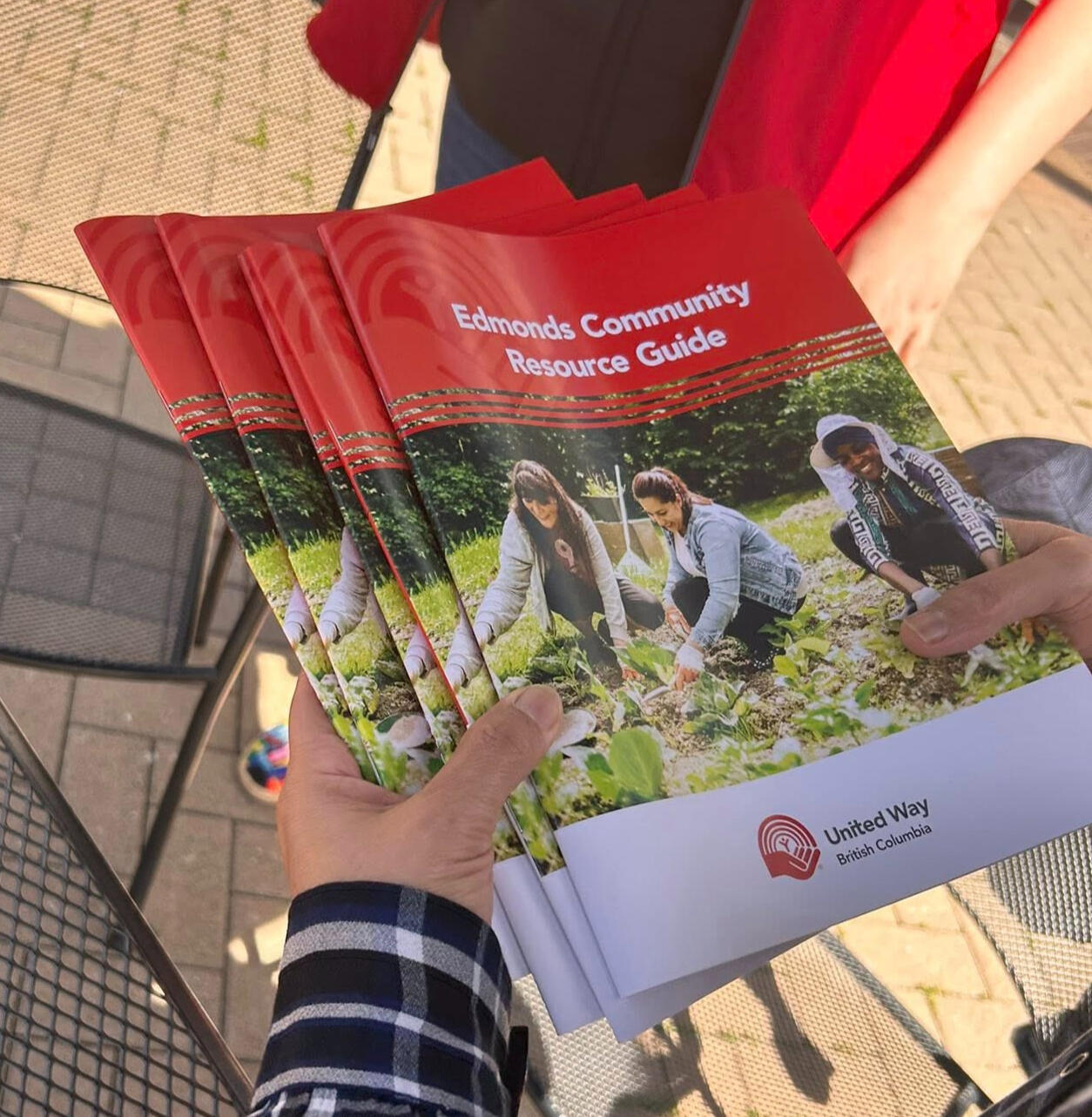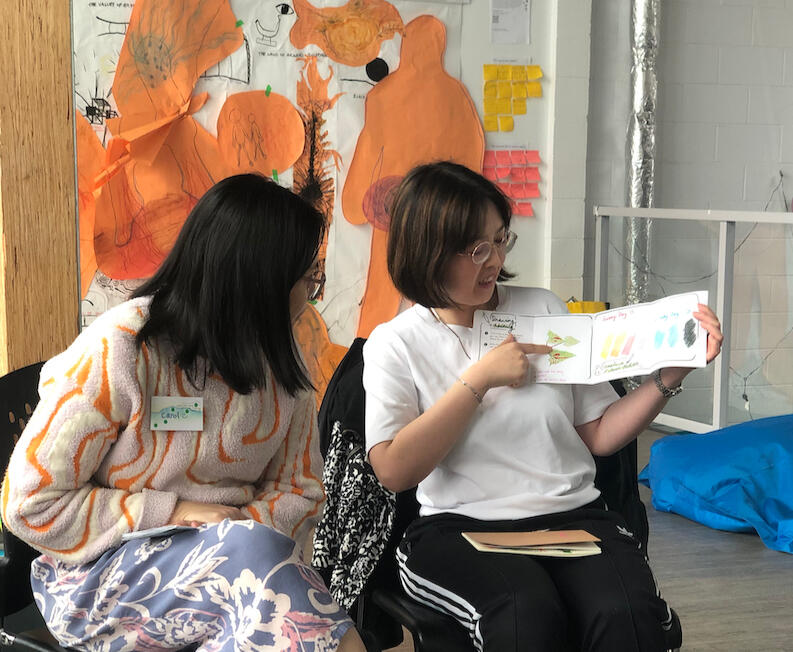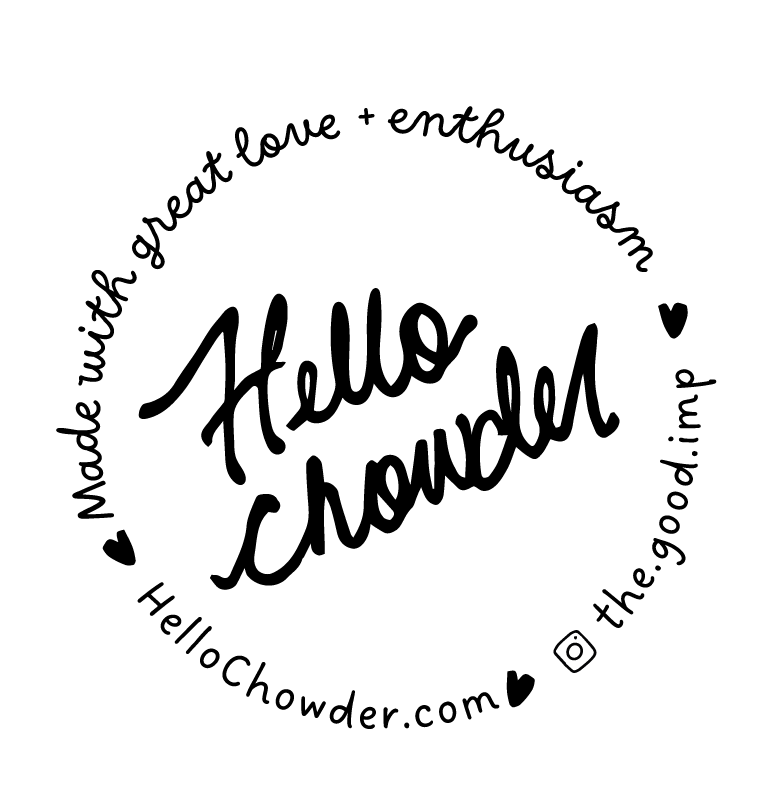Allison Chow
designer + arts-based researcher
Turning questions into creative tools and workshops into places of wonder – designer, researcher, and maker of things that spark conversations.
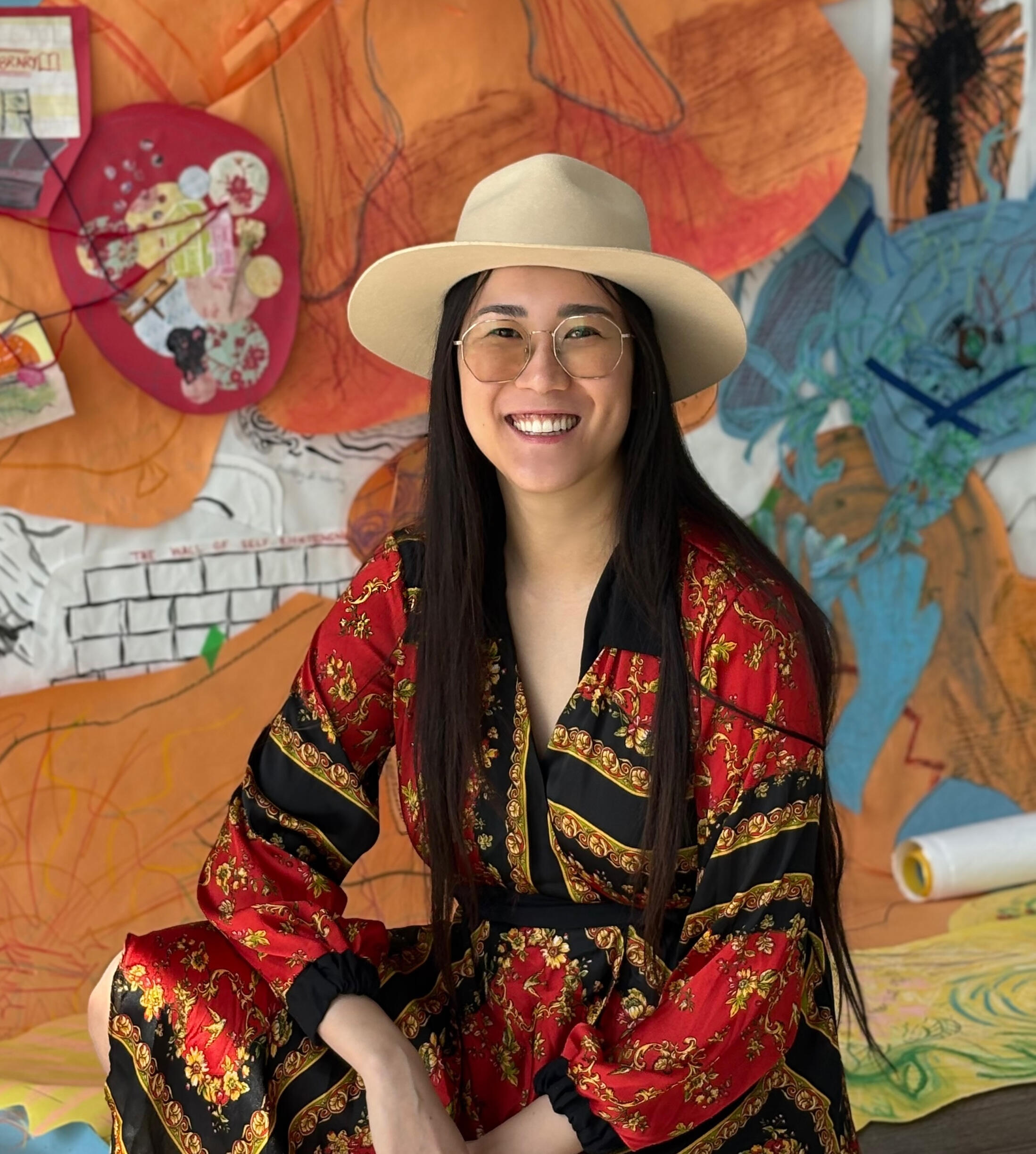
Work
Here’s a peek at some of the things currently percolating in my world — a mix of art-making, research, and community-rooted experiments. Some are finished, some are growing, and some are still figuring out what they want to be when they grow up.
Emotion Cartography
A community-based arts project exploring how we feel, where we feel it, and how we create meaning together.
Community Capacity Guide
A legacy resource that documents five years of grassroots leadership, place-based problem-solving, and mutual aid in Edmonds, Burnaby, BC.
Design for Disability Inclusion
Curiko: Sparking curiosity and growing connections with a community-lead platform.
Talking to Strangers
Knowledge Co-Creation Meeting strangers to practice deep listening, intuitive conversation, and creative expression through collage, mark-making, and somatic movement.
Playground
Welcome to the playground — where ideas run barefoot and night sketches bloom. Here live my zines, one-off illustrations, show experiments, and creative side quests. They’re tender, messy, often made at midnight — things I made to listen, get lost, or just play.
Poetry Machine
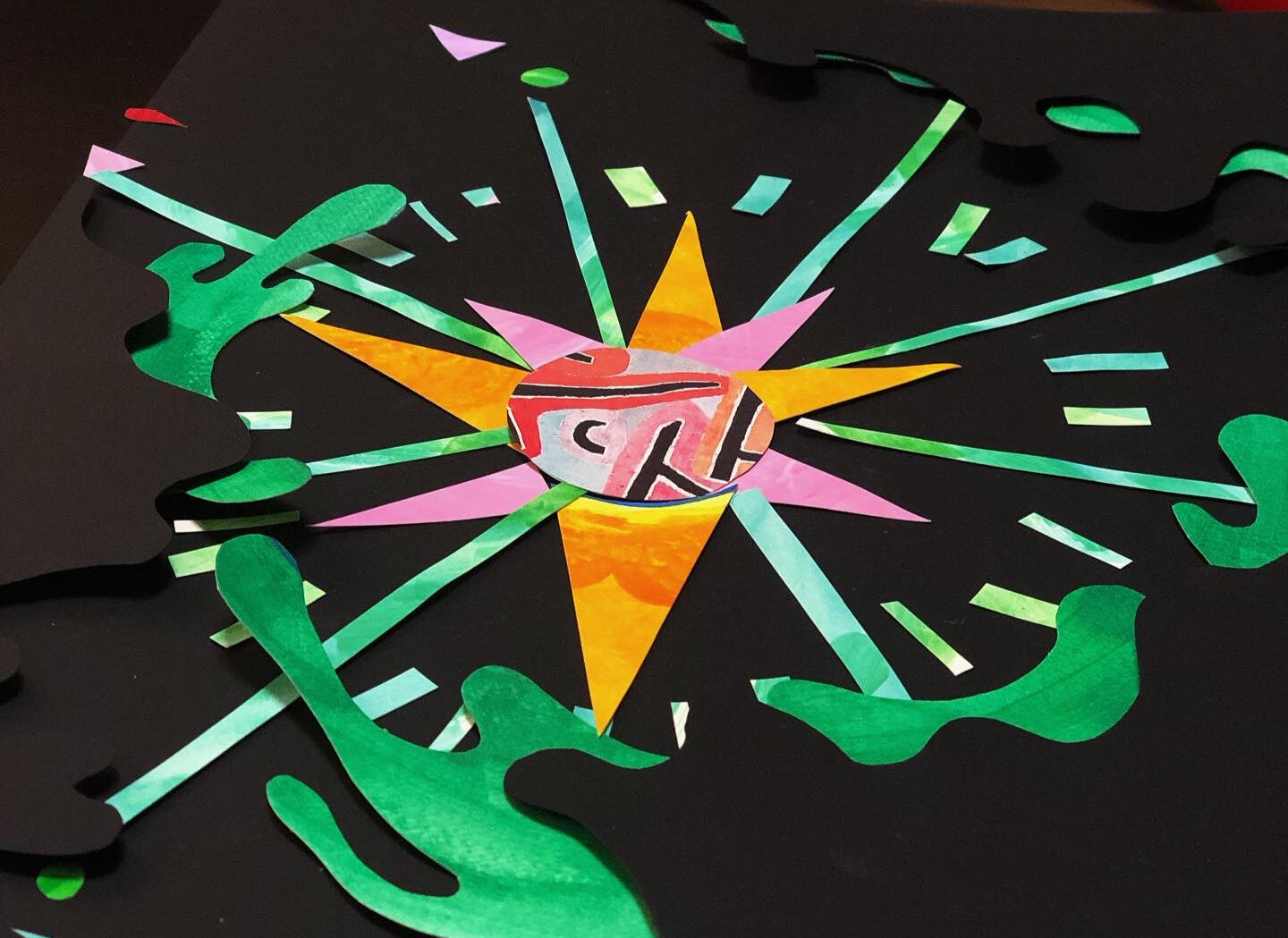
OverviewThis 2023 artist-in-residence work grew from the themes in my poem My Mother’s Daughter, exploring what it means to create from a place of safety and visibility—especially among other third-culture kids. Together, we had honest conversations about belonging, the roles we take on, and the parts of ourselves we’ve lost along the way. These discussions surfaced grief I hadn’t realized I was holding.This experience led me into deeper somatic exploration, including the work of therapist and author Hilary McBride. Her book The Wisdom of the Body introduced me to the idea of “Body Hierarchy”—the myth that some bodies are more valuable than others. Many of us live in cultures that view the body as something to overcome, ranking it by youth, skin tone, gender, or ability. McBride writes about how we often dissociate from our bodies to survive systemic oppression or relentless productivity. But when we disconnect from pain, we also lose access to joy.To fully thrive, I believe we need to reconnect—with our bodies, our lineages, and each other. Somatic wisdom traditions across the globe offer tools for this. They help us honour the diverse ways we move, think, feel, and know. Practicing this awareness in community can spark innovation and resilience, especially in places that aren’t always designed to accommodate change.
Sector
Community Arts
Public Engagement
Social Practice
Presenting Partners
Deer Lake Gallery
Massy GalleryFunded by
NVRCServices
Facilitation
Workshop Design
Art Direction
Collage
Participatory Installation
Timeframe
May 2023 - June 2024
Available upon request
Lonsdale: Listening to the Land and Industry
As part of this residency, I immersed myself in the history of the Lonsdale Quay area, drawn to its working-class roots and industrial evolution. Artifacts from the Seaspan drydocks—valves, lifting lugs, thick ropes—offered tactile traces of the shipbuilding legacy here. This site helped launch 109 Victory-class ships during WWII and served as a rare entry point for women in trades in Canada.But with industry comes tension—between land use, community needs, and environmental stewardship. A lecture at MONOVA on local economic development made this especially clear: the past and future coexist here, layered on top of each other, sometimes in conflict.Curious to expand my poetry practice beyond the page, I visited different sites around the Shipyards, absorbing sounds, textures, and stories. People like Ana and Barry at Seaspan shared their knowledge of the Careen and Panamax floating drydocks—structures that now support conservation research. An elder told me about his father’s 30-year career at the “Burrard Docks.” These encounters gave me new ways of seeing the land—and reminded me that stories often begin in the middle, not the start.
Co-Creation: Building the Communal Poetry Machine
Over two months, I developed a public-facing installation called The Communal Poetry Machine. It included:
A reverse colouring zine with maps and a custom soundscape by local artist rec12, using field recordings from the area.
Four directional Ocului and five shifting sculptures designed to be interactive talking tools, inviting community members to respond, mark, and move through the space.
Somatic prompts encouraging participants to tune into their bodies—how they arrived, how they moved, and what nonverbal stories emerged.
The project asked: How do our bodies remember? How can public art hold space for that remembering? Some visitors found comfort in a small gesture—a shared movement or a reassuring touch. Others responded with vibrant marks and colours, expressing feelings of joy, tension, or transformation. Themes like uncertainty, the burdens we carry, and the quiet desire for change emerged through this shared experience.
Somatic Sessions & Sensory Collage
Throughout the residency, I hosted three community sessions, including one co-led with a somatic therapist. Participants engaged through storytelling, sound, free movement, and mark-making. Together, we explored how sensory memory and embodied experience can shape art and community connection.
Shifting Context: Deer Lake Gallery Installation
In November 2023, I brought the ideas behind the Poetry Machine to the Deer Lake Gallery in partnership with the Burnaby Arts Council. This working session included:
Collaged materials: my photographs from the area, archival images, and borrowed objects, including historical Hak Chu game pieces that inspired Nathan Lee’s nearby installation.
Participant contributions: personal items representing each person’s relationship to the gallery and neighborhood.

Collage Making

Narrative Synthesis
The session welcomed BAC board members, city planners, and local residents. We reflected on questions like:
What role can a gallery play in a changing community?
How do we care for one another across generations?
What does art look like when it's not about a finished product, but about process and presence?
People shared personal stories—some about stress and broken relationships, others about healing and community care. It reimagined the gallery as a third space: a place where meaning is made together, in motion, and in dialogue.
Massy Gallery Installation
The most recent installation of the Communal Poetry Machine was featured at Massy Arts on Saturday, June 8th, 2024, as part of
Ravelling Seams: Visioning Hope – a group exhibition featuring work by myself, Sena Cleave, and Rawan Hassan. Ravelling Seams was steeped in mixed identities—telling stories and advocating with our lives. As the show’s description shares: “Ravelling Seams: Visioning Hope brings together a collection of unfolding stories. From strolls in shipyards to embodying home from away, the artists in this show braid intimate reflections with public spaces, archives, and the touchstones that constitute them.”This was my first group show, and being part of it expanded my understanding of collaboration and solidarity across cultures, disciplines, and lived experiences. It reminded me how art can be a way of walking alongside one another—offering plurality and many different ways of being to the community. Throughout this process, I’ve realized how vital it is to seek connections outside of a silo. While undisturbed time for reflection and documentation is essential, so is being in dialogue—both with other facilitators and with the communities we work alongside. Staying connected helps prevent distortion or the unintentional centering of a single perspective. It's part of building a pluriverse, where everyone can experience belonging and reciprocity. I’ve been thinking more and more about amplification—how to lift up other forms of knowing, feeling, and expressing. That also means sharing power: inviting facilitators from different disciplines and lived experiences to shape the work, rather than always leading it myself. This shift feels necessary if the goal is to create more just and responsive creative spaces. Read more about the show on Massy Arts' website.
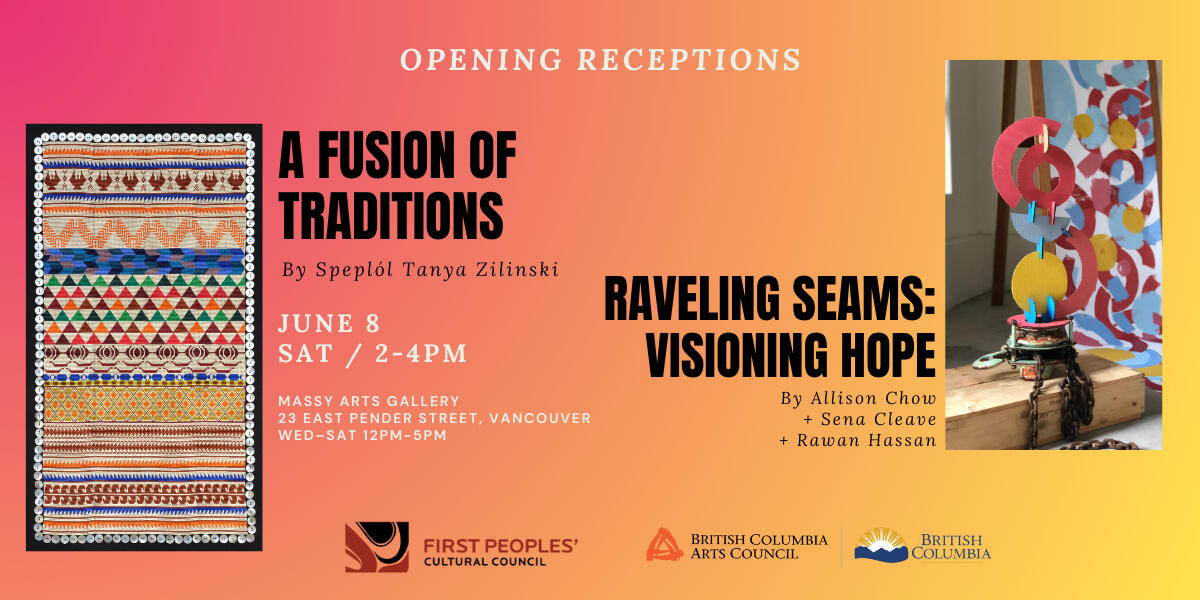
Talking to Strangers
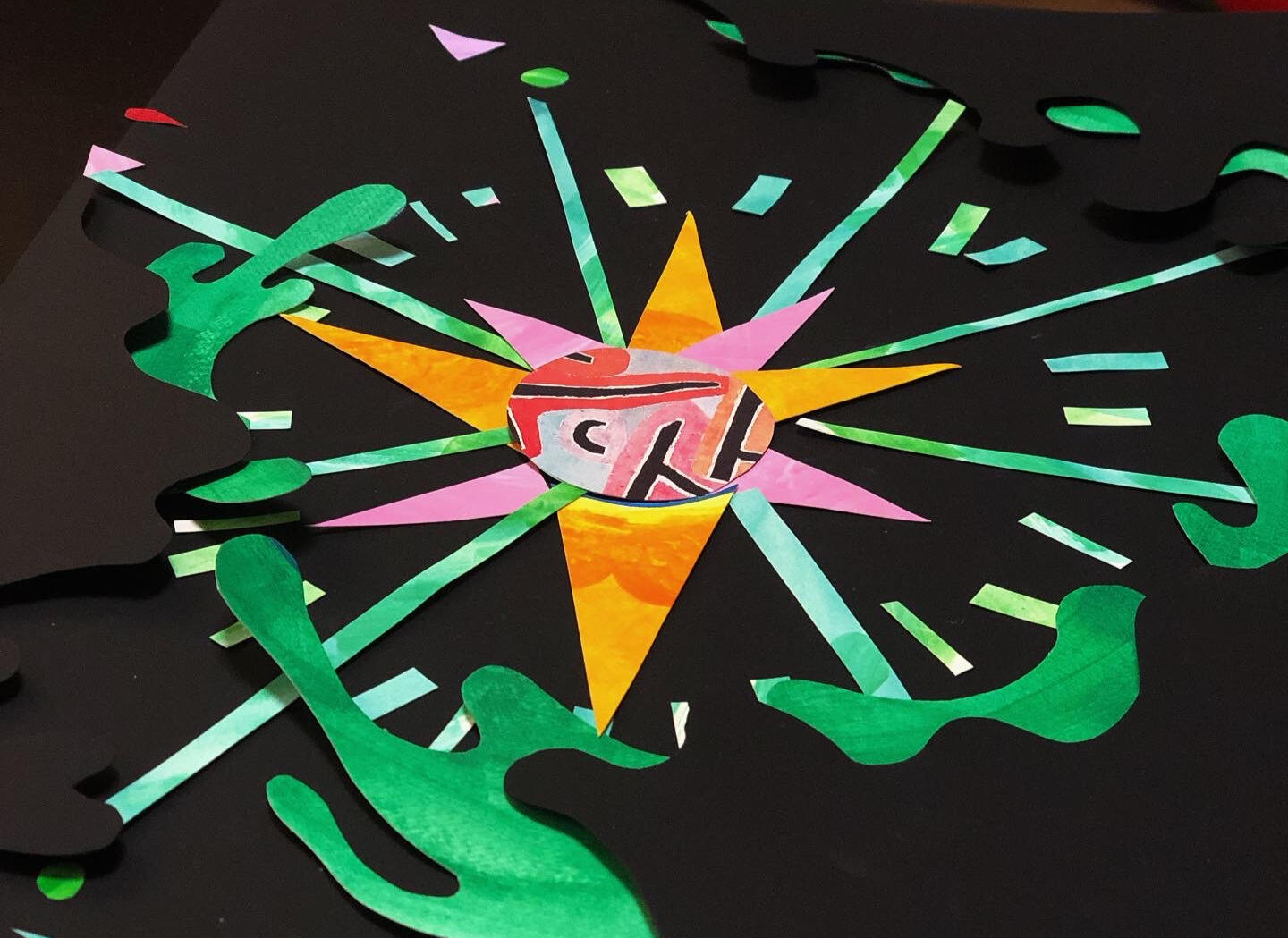
OverviewAt the beginning of 2024, I set to work to amplify the magic I’d saw in the Communal Poetry Machine—moments where strangers showed up, listened deeply, and offered stories that surprised even themselves.This time, I didn’t want to be the sole facilitator. I wanted to co-create tools that others could use to guide their own tender conversations. So Talking to Strangers was born: a year-long exploration into shared vulnerability, intuitive art-making, and what it means to be seen.
Sector
Arts & Culture
Mental Health
Community EngagementFunded by
Self-Initiated + Community ParticipationServices
Facilitation
Workshop Design
Visual Art
Somatic Practice
Research
Community Co-Creation
Timeframe
Jan-Dec 2024 (Monthly)
Why Strangers?
The focus on “strangers” was inspired by the curious way we often find it easier to share deeply personal, unresolved experiences with strangers—like fleeting conversations on a bus—while we may struggle to reach that same openness with those closest to us. Kahlil Gibran’s words, “Your other half is not the one you love, it is you in another time yet in the same space,” resonate with this idea. It made me wonder: what if we could bring that “other half” of ourselves—our hidden narratives, vulnerabilities, and experiences—into spaces where we tend to hold back?
Monthly Workshops
On the first Tuesday of each month, I meet with the strangers fate brings to Slice of Life Gallery, a hub for creatives. Together, we practice active listening using a custom deck of reflective questions, tuning into our intuition, and drawing on the wisdom of our bodies. Participants explore what kind of support they’re seeking—whether it’s love, courage, strength, or simply space to breathe. Through somatic movement, conversational games, and intuitive art-making like collage, mark-making, and stamp creation, we nurture deeper connection with ourselves and one another.
Why this Matters
Therapy isn’t accessible to everyone—and many still face stigma around mental health.
We often lack language for our inner worlds, especially in a culture obsessed with productivity.
Crafting helps us think differently—collage and drawing can surface what words can’t.
Safe, supported groups are powerful mirrors. We learn to witness without fixing.
Listening is an act of resistance—a way to soften the edges of isolation and disconnection.
The Big Idea
The Creative Process — One of art’s most profound roles is to help us move through personal emotions while acknowledging the larger social, cultural, and political forces that shape us. The space created in this project with community members focus on the creative process itself rather than producing “good” art. Each month, I introduce new explorations, such as Neurographic doodling, breathwork, or visualization. It’s less about technical mastery and more about building a personal relationship with art.Over the course of two hours, we cultivate a space for observing without judgment— for our collective humanity and “becoming.” The workshop offers practice for tools like active listening, curiosity, and camaraderie.
Stochastic Decision-Making — Collage, in particular, can be a window into the subconscious, allowing us to quickly combine images and symbols in ways that transcend logical connections. A key part of this practice is introducing stochastic decision-making—inviting randomness or chaos into the creative process, whether by flipping a coin or picking a card. This approach helps us happenstance and uncover hidden narratives, hopes, or doubts that often lie between the cracks of our everyday facades.

Collage Making

Narrative Synthesis
Embodied Knowledge and Research
The workshop also functions as a piece of citizen- engaged research, helping us understand how we’re coming together and what needs or offerings emerge from the community as neighbours contributed to a “Communal Poetry Deck.” After each workshop, they added their creations and words of wisdom, which you can see in the deck. In her 2011 work Dancing Across the Page, Karen Barbour argues that knowledge is not solely a product of the mind but is deeply embedded and incorporated in our lived experience. Barbour introduces the concept of embodied ways of knowing to emphasize the importance of a researcher’s full, embodied involvement in the environment they seek to understand, as well as in the broader research process. She challenges the notion of knowledge as something detached from the material world or separate from our inner life, proposing instead that it is formed through a close relationship between the body—its perceptions, sensations, and reactions—and the external world. Barbour also highlights the embedded nature of knowledge, which is constructed through lived experience and through learning from others. This perspective underscores that knowledge is not abstract or removed but is shaped by our interactions and the physical realities we engage with. She describes a form of knowledge that is both created and constructed through embodied experience, suggesting that how we know is deeply influenced by our physical presence in the world. Barbour’s work draws a distinction between three key processes: the construction of knowledge, the research process, and the choreographic process, illustrating how each of these is intertwined with embodied experience, or a concrete practice like art making for synthesis (Figure below).
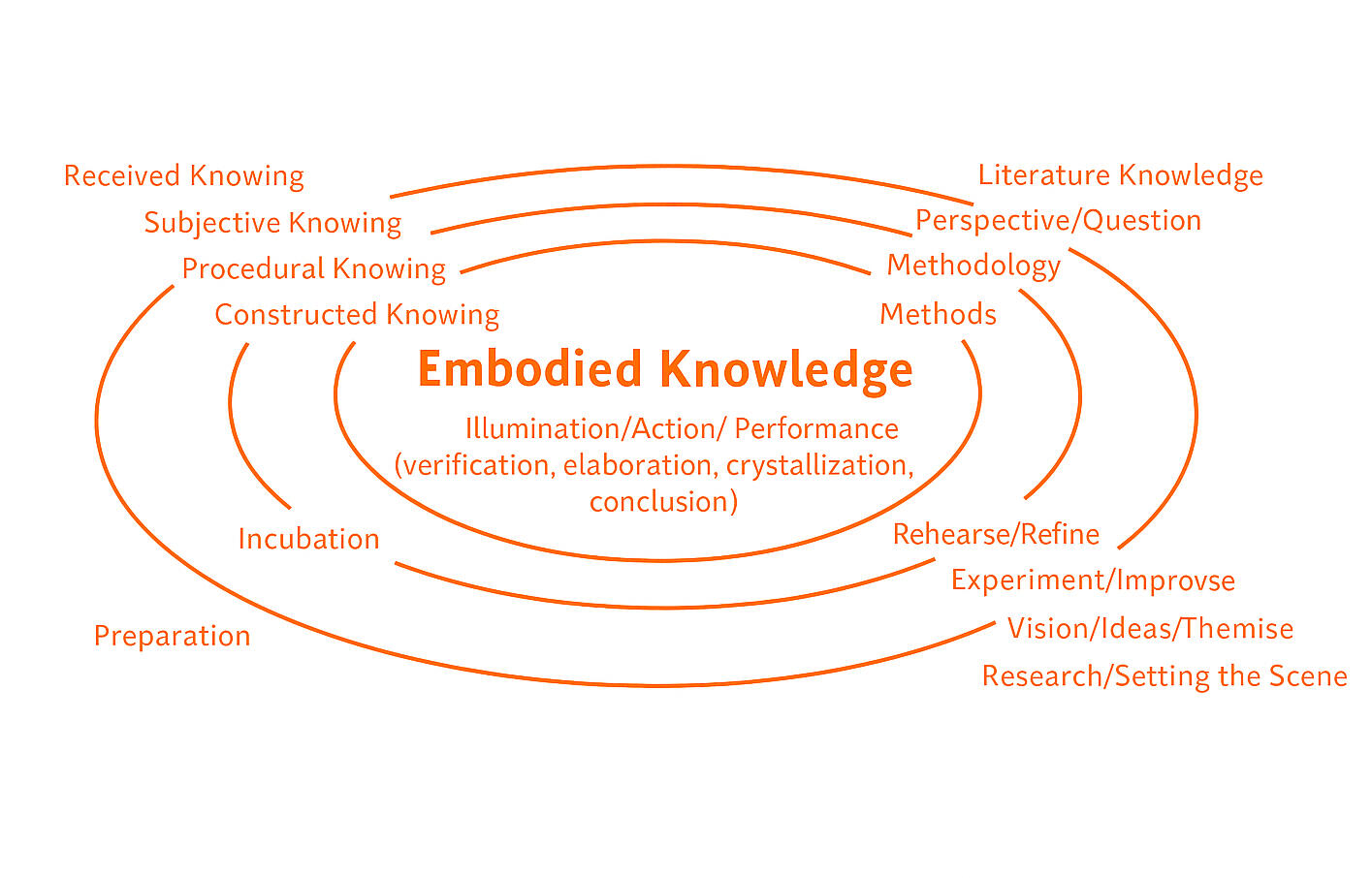
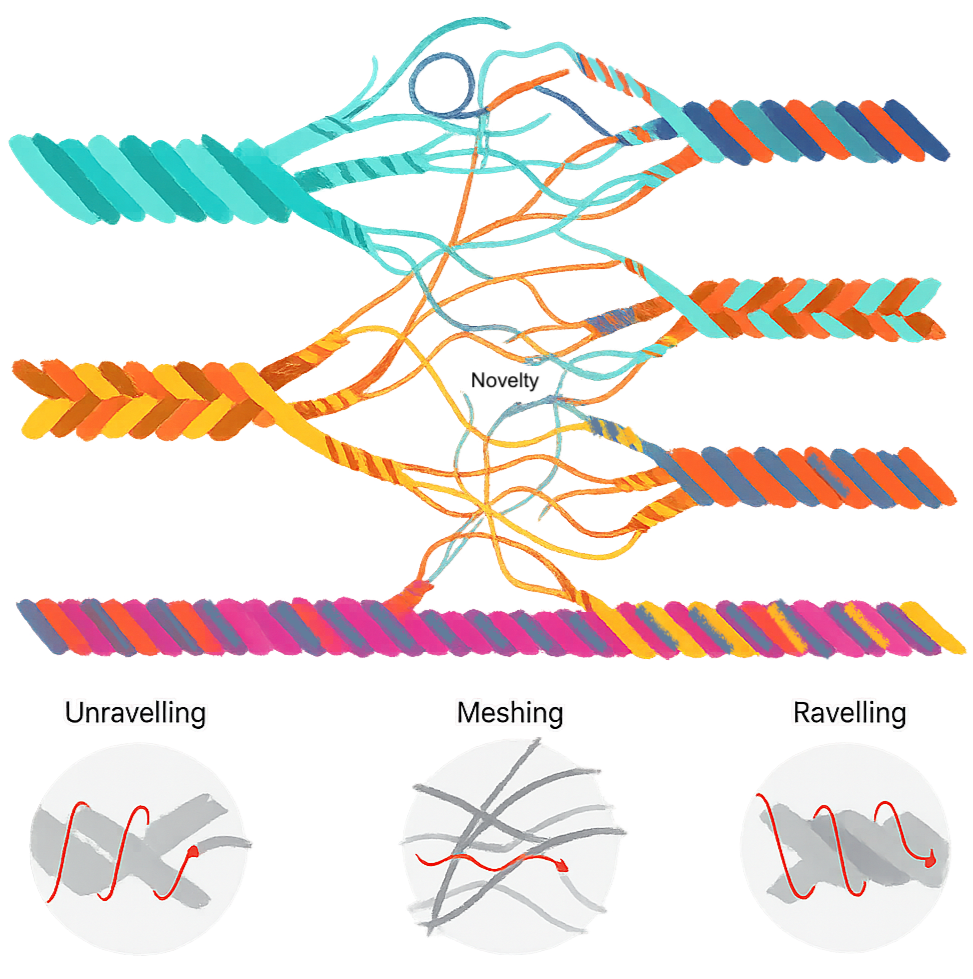
Knowledge Co-creation
By making it a community engaged practice we can engage in the 3 key processes of knowledge co-creation:
Unravelling — Exploring assumptions, sharing experiences, images, stories
Meshing — Creating new concepts, discarding, sythesizing, connecting perspectives
Ravelling — Creating narratives, shared meaning, finding applicable knowledge.
The Reflection Deck
The Reflection Deck emerged during a painful stretch in late 2024—amid the tragic events unfolding in Gaza, personal grief from family loss, and the quiet weight of burnout. I felt numb. I didn’t know how to move forward, or if I’d ever feel like myself again.In the face of global conflict and personal despair, what I had to give felt so small. I was constantly turning over my beliefs about justice, freedom, and humanity—trying to make sense of what it means to be alive in this moment, in this body, in this community. The internet made it feel like the people who needed help most were just outside the window, yet I could only respond in slow motion. During that time, collaging became a quiet, grounding act. I didn’t need a plan. I just needed to do the next right thing: cut a piece of paper, make a shape, keep going. Even on days I felt unhinged, the act of assembling something tangible brought me back to myself. These small gestures became a way to rebuild, bit by bit—to explore what it meant to be strong, courageous, wise, or loving in the now.Prompt Questions — When words felt distant, journaling helped me find my way. I began collecting questions—the kind that nudged me toward clarity and connection. Some came from therapy, others from late-night conversations, and many from moments of stillness. Each card in the Reflection Deck holds one of these questions, paired with a “deepener” in the coloured strip at the bottom. These deepeners invite exploration into topics we’re often taught to avoid—feelings, boundaries, grief, desire. Some cards simply end with “...” as an invitation to fill in the blank yourself. This practice helps us stretch into discomfort, sense when to speak or hold silence, and bring more honest language into our relationships.
The Communal Poetry Deck
At the end of each session, I invite participants to add their reflections— whether it’s a word of kindness, encouragement, advice, or even a title—to their card, which then becomes part of the communal deck. They can also choose to include their contact information if they’d like to stay connected with others. I love how this process builds agency and celebrates growth. It’s about imagining who we were two hours ago—the version of ourselves that came in with a question or something unresolved—and then creating something to gift that person. This outward act of caring for others also helps us realize how much we have to share with one another. We’ve had people from all different backgrounds take part, and common themes that come up include new beginnings, career transitions, breakups, and the search for rest in a busy, restless life. Participants often exchange contact details, and some have even formed their own meet-ups outside of the workshop. It’s been incredible to see how this process of shared reflection can spark real connections and ongoing support.
Gallery Takeover at Slice of Life
To celebrate the work, I brought the Communal Poetry Deck and participants’ original collages to a group show at Slice of Life. A few contributors were Slice regulars, but many didn’t consider themselves “artists.” It felt important to challenge the idea of who gets to make an impact through art—and to show that transformation often happens not in the final piece, but through the act of creating and engaging with it. At the show, I created an activation area where visitors could pull a card from the deck and either spark a conversation with someone new or make their own reflection in the collage-making zone and add it to the wall. Watching people interact—seeing themselves as part of the process—was deeply moving. Some participants even returned with their families and close friends, sharing what they had made. It became a celebration of how art, in both its making and experiencing, holds the power to connect, teach, and transform.
Emotion Cartography
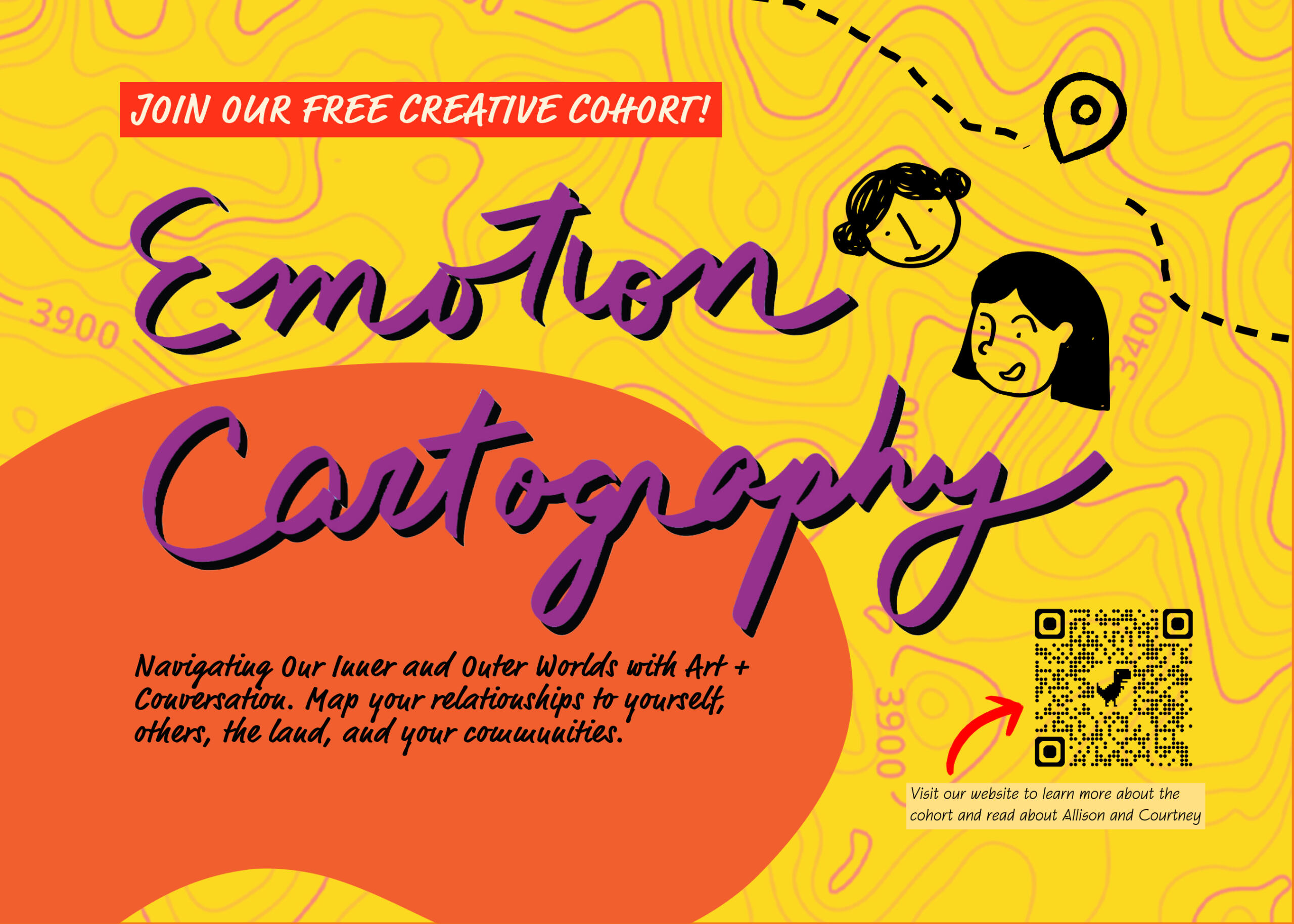
OverviewA community-based arts project focused on exploring how we feel, where we feel it, and how we create meaning together. Over five weeks, 14 Vancouver participants engaged in an arts-based research experience, using creative practices alongside traditional research tools like surveys and data visualization to map their emotional landscapes. Sponsored by PosAbilities, with funding from Vancouver Coastal Health, and presented at Alternatives Creation Studio—a space dedicated to bridging differences and fostering connection—this project cultivated personal insight, strengthened community bonds, and offered a fresh approach to neighborhood engagement through emotional cartography. The results have meaningful applications for wellbeing, community building, and inclusive policy development.
Sector
Community Wellness
& Participatory ResearchFunded by
PosAbilities
(with funding from
Vancouver Coastal Health)Services
Arts-Based Research
Trauma-Informed Facilitation
Somatic Workshops
Discovery Activities
Data Collection Tools
(Surveys & Visual Prompts)
Emotion Cartography
Visual Identity
Layout Design
Cohort Communications
Final Documentation
Timeframe
5-week cohort +2 months prep & wrap
Why map emotions?
I wanted to explore how people can use art as a form of research to make meaning of their emotional experiences within a caring community space. The goal was to move beyond just talking about feelings and instead map emotions as lived, physical, and social phenomena.Using traditional research methods like surveys and data visualization alongside creative processes, we aimed to capture how moments of connection to self, community, and place can shift over time. I was particularly excited to see how participants’ relationships with their own emotions and the neighborhood around them could change—and how this could inform not only personal growth but also broader community engagement or policy conversations.
Who was it for?
This project was designed for a diverse group of 14 participants in the Commercial Drive neighbourhood in Vancouver, from all walks of life and varying experiences, brought together by a shared curiosity to explore their emotional landscapes through art and different ways of knowing. The series was sponsored by PosAbilities, funded by Vancouver Coastal Health, and presented at Alternatives Creation Studio—a space dedicated to bridging differences between disabled and neurotypical people to foster meaning and connection.
"Data collectors"
Each week, participants were invited to engage with specially designed “data collectors” — creative prompts meant to be colored, torn, and collaged in response to their sensory and somatic experiences. We began from our comfort zones, exploring patterns and elements found in our places of rest—those spaces where we feel safest. Then, we gradually moved outward: to natural spaces, community and public spaces, and finally to “edges and discovery,” where new and unfamiliar places invited reflection. Our last data collector focused on memory and meaning, serving as a retrospective on our time together. These data collectors gently guided participants into progressively more challenging or vulnerable spaces, encouraging them to notice shifts in behavior, recurring emotional patterns, and bodily sensations linked to different environments. The goal was to illuminate what these inner responses might reveal about the needs and rhythms of our emotional landscapes.
What we did
Over five weeks, participants engaged in weekly sessions combining embodied “data collectors” (reflection prompts and simple surveys), guided body scans, and creative activities. Together, we:• Created an agreement,
with the "gifts" we would like to share and give each other to support this journey• Created "north" + "south" pole
base-line of the emotions we feel drawn to exploring and the ones that feel dangerous to excavate.• Traced our bodies
onto large paper, visually mapping emotions like anxiety, trust, and compassion as shapes and textures.• Explored physical, emotional spaces
by drawing, collaging, and layering symbols linked to the neighborhood and personal experience.• Used data visualization
to connect individual and collective reflections throughout the week, building a shared emotional “map” that grew more colorful and complex over time as we negotiated space, meaning and connections.• Created opportunities
for participants to share and synthesize their experiences, forming a supportive network rooted in mutual care.

Ways We'd Like to Receive Support

Ways we'd like to gift support
This combination of traditional and arts-based research methods created a rich snapshot of the neighborhood’s emotional geography, fostering new connections between people who might not otherwise cross paths. The process invited reflection on personal emotions while opening pathways for community dialogue—useful for everything from individual wellbeing to informing inclusive policy or development projects.
What shifted?
Throughout the project, I witnessed participants develop their own creative research practices—some used texture rubbings, audio recordings, or poetry; others began carrying sketchbooks into public spaces as tools to ease anxiety or process trauma. One participant brought a vibrant patchwork heart to therapy sessions as a visual bridge for conversation. Moments of connection deepened—not only with self but also among participants and their surroundings. We closed the series with a circle and a web of yarn, symbolizing the tangible bonds formed. People offered each other resources, invited creative collaborations, and committed to attending events together to reduce social anxiety. These shifts demonstrated that emotional work, when done in community, ripples outward—building systems of support, shared creativity, and collective knowledge that extend far beyond individual reflection.This project also led to a feature on the Innately Science blog, where I reflected on what it means to become an “emotion scientist” through art-making. 🔗 Read the article
Ongoing Learnings
This project was designed not just as a one-time experience, but as a seed for ongoing reflection, connection, and place-based meaning-making. For many participants, it created space to pause and notice emotional patterns and habits, offering language, tools, and visuals that could be revisited or deepened later.“I realized how much I ignore my body. This made me feel like I could actually listen, like I was allowed to.”“Mapping my emotions helped me understand where I shut down—and where I open up.”Participants shared that the process helped them feel more attuned to their bodies, more connected to the spaces they move through, and more aware of how those spaces shape their inner lives.Outside of the interpersonal, we also generated a rich snapshot of the neighbourhood—moments of connection to self, to community, and to place that might otherwise go unnoticed.“It changed the way I walk through my neighbourhood. I see things differently now.”This kind of emotional cartography could be a useful tool for policy makers, urban designers, and community organizers, helping them engage with the hopes and dreams of a neighbourhood from the inside out—especially among people who may not usually cross paths.The project’s ideas have also lived on through new iterations. During a school-based artist residency, I adapted this approach for grades 4–6, using simplified materials and prompts to help students explore how emotions show up in their bodies and surroundings.“When I feel nervous my legs get fast.” —Grade 4 participant
“This helped me know how to calm down when I’m angry.” —Grade 6 participantEven at a young age, students were able to identify recurring feelings tied to space, talk about stress and comfort zones, and begin building personal insight through art and discussion. It affirmed for me that this work scales beautifully—across ages, bodies, and community contexts.
Community Capacity Guide

“It was it an incredible heart throb to read through! There’s SO MUCH work, memories, specific moments, quotes you somehow managed to pack in! Your writing is brilliant... Especially impressed since you did this all during probably the most intense/chaotic period this team has seen.”
— George Berking, Community Engagement Specialist, United Way BC
In the spring of 2025, as the Legacy Curator for United Way BC’s Hi Neighbour initiative in Edmonds, I was brought in to co-create a digital and printed Community Capacity Guide—a legacy resource that documents five years of grassroots leadership, place-based problem-solving, and mutual aid. This was Hi Neighbour’s largest and most complex initiative to date, in both scale and depth. Edmonds, a neighborhood in Burnaby, BC, is one of the most ethnically and linguistically diverse areas in Metro Vancouver. With over 100 languages spoken and a high population of newcomers, it’s a deeply multicultural place—and one that traditional nonprofit services have historically struggled to reach due to language barriers and fragmented information networks.Rather than offer outside-led services, Hi Neighbour’s model centers resident-led action. It supports local champions to identify neighborhood needs, build relationships, and lead community projects from a strengths-based perspective—recognizing that residents are often the most equipped to see both the problems and the potential in their surroundings. Check out the United Way blog on the project.
Sector
Community Engagement
& Social ImpactClient
United Way BC
Services
Participatory Research
Story Development
Narrative Strategy
Editorial Planning
Qualitative Research
Workshop Facilitation
Print & Layout Writing
Asset & Resource Mapping
Community Interviews
Ethical Storytelling
Internal Collaboration
Team Support
Timeframe
3 months (Jan–Apr 2025)
Approach
An important part of this work was capturing the passions and hopes of community champions—some who had been involved since day one, others just beginning to find their voice. I avoided relying on formal interviews or English as the default, instead leaning into the vibrant, multilingual patchwork that defines Edmonds. This meant showing up in all kinds of places: community school rooms with women-only English learner groups, library art events, a bustling business expo, and even cozy kitchen tables in people’s homes. To meet people where they were—literally and figuratively—I designed tools that could flex: activities that worked across languages, group sizes, comfort levels, and communication styles. Whether someone shared through stories, gestures, drawings, or just a quiet presence, there was space for them in the narrative we were building together.
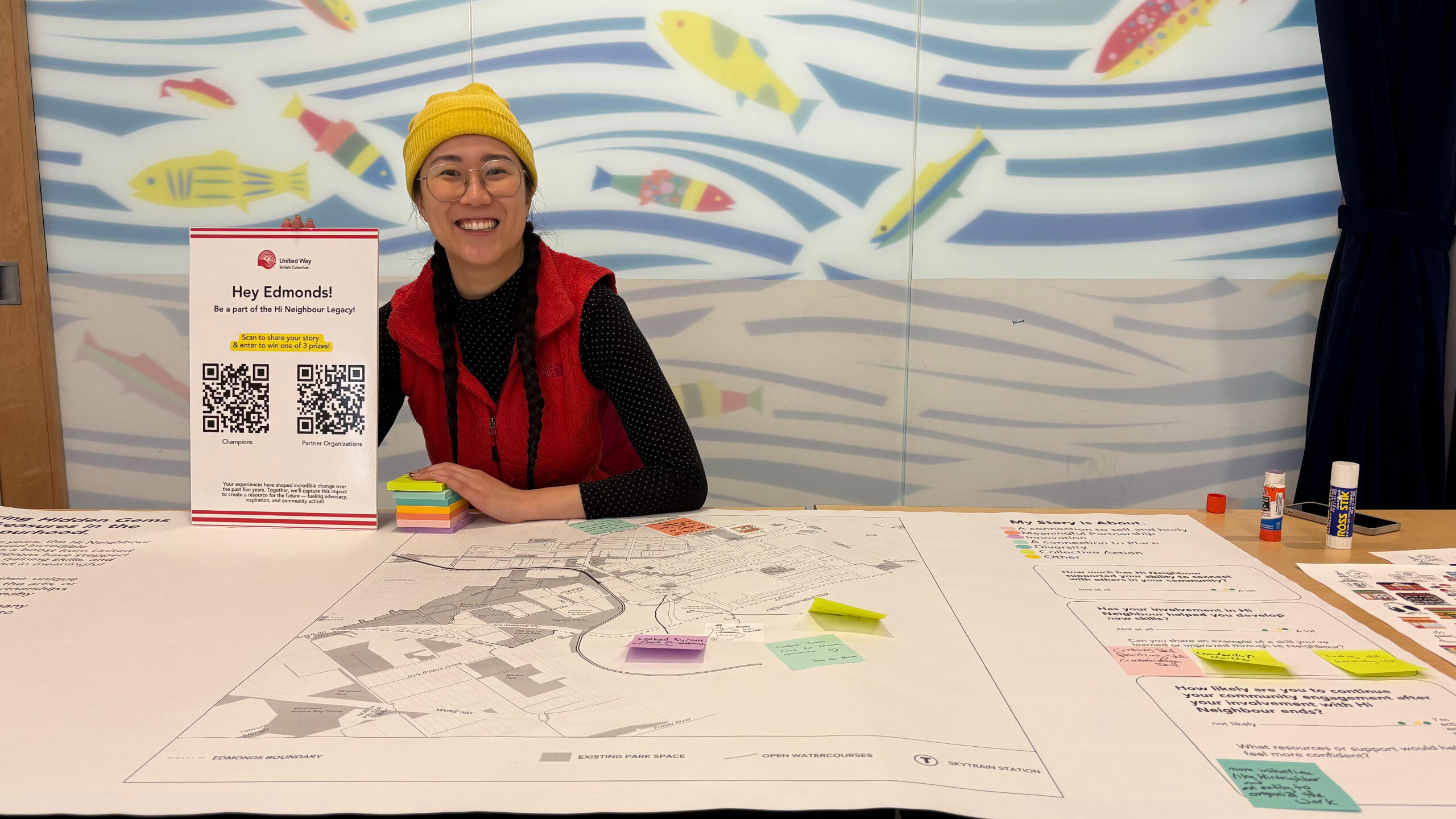
What happened?
I worked closely with the Community Engagement Specialist and Community Builder to synthesize five years of collective impact into a guide that was both reflective and actionable. My contributions spanned:
Writing and narrative design
I led the development of story structure, voice, and flow, writing pieces that honored the emotional depth and cultural nuance of the work.
Editorial strategy
I designed the story selection framework using Hi Neighbour’s Theory of Change, helping the team evaluate which stories best represented personal transformation, collective action, and community impact.
Facilitation and team support
Through several rounds of collaborative workshops, I helped the team—who were deeply invested in the material—make editorial decisions with care, clarity, and alignment.
Participatory research
I conducted one-on-one interviews with Community Champions, prepared with insight from the internal team. I implemented ethnographic “story share-backs,” allowing participants to review and refine their narratives before publication.
Mixed-methods data collection
Alongside interviews, I created Typeform surveys focused on Edmonds’ past, present, and future, and designed art-based mapping exercises to visualize the impact of neighbourly connection.
Asset documentation
I helped catalogue all active community resources—including gathering spaces, local grants, and step-by-step guidance for organizing projects—aligned with United Way’s framework for organizing, mobilizing, and formalizing grassroots efforts.
Story Share Back
A central part of my methodology was practicing story returns or story share-backs—a participatory approach rooted in ethnographic research. After each interview, I returned a written narrative draft to the participant, inviting them to read, reflect, and respond. This isn't just a fact-checking step—it's an ethical and relational process. It gives participants the opportunity to refine details, clarify meaning, and offer feedback on how their voice and experience were being represented. In a community as diverse as Edmonds—where language, lived experience, and expression vary widely—this practice built trust, mutual respect, and accountability. It also led to deeper, more accurate stories that honoured both personal truth and broader community impact. Story share-backs ensured that narratives weren’t about people—they were created with them.
Mapping Resources & Support Systems
Alongside story documentation, I worked closely with Mary, the longtime Community Builder who played a key role in making every Hi Neighbour moment happen over the past four years. Together, we pieced together a comprehensive picture of what supports truly scaffolded community leadership in Edmonds—from available grants to physical spaces, informal support networks, and often-overlooked resources like child-minding. To do this, I conducted journey mapping for each of the deep-dive community champion stories, tracing what helped them grow emotionally, socially, and motivationally over time. We examined not only what resources existed, but how and why they mattered—what helped people show up, feel supported, and sustain momentum in their community-building efforts.This section of the guide is both practical and story-driven, shaped not just by policy or program logic, but by the lived reality and wisdom of the people it’s meant to serve:
Funding opportunities and local supports are shared in plain language
Listings are grouped by theme and framed through real experiences
Layouts are inspired by “storybook” preferences voiced by community members—making it inviting and accessible
Check out the guide here
Lasting impact
This project allowed me to braid editorial judgment, ethical storytelling, and community-based research into a single, human-centered publication. The final guide is both a celebration of what’s been built and a practical toolkit—something Edmonds residents can use to continue shaping their neighborhood on their own terms.Spending time documenting these stories transformed me. It was a privilege to witness the muscular, gritty hope that lives in Edmonds. I followed the path of Community Champions like Mary, a resident Community Builder who supported countless other residents, many who faced extreme financial and social —who can now be counted amongst a robust group of leaders, shaping collective action with confidence and care. Through her leadership and others like hers, community gardens have flourished, knowledge exchanges have taken root, and a Business Improvement Association has begun to emerge, collaborating with researchers to shape the future of the neighborhood. It was an honour to carry these stories with the dignity and admiration they deserve.One of the most unexpected and moving pieces of feedback came from people whose stories weren’t featured as deep dives. Even the workshops I hosted—where we reflected on what’s changed through the various layers of the Hi Neighbour Initiative—sparked a sense of recognition. Some said they finally felt seen. It was a beautiful reminder that being seen, having your story held, and knowing you belong is a fundamental human need. And when shared with care, our stories can become a kind of legacy—one that lifts up not just individuals, but the places we all call home.

Sandy, community co-ordinator at STRIDE Community School

Women's English Speaking Circle at STRIDE Community School
Designing an Experience Platform
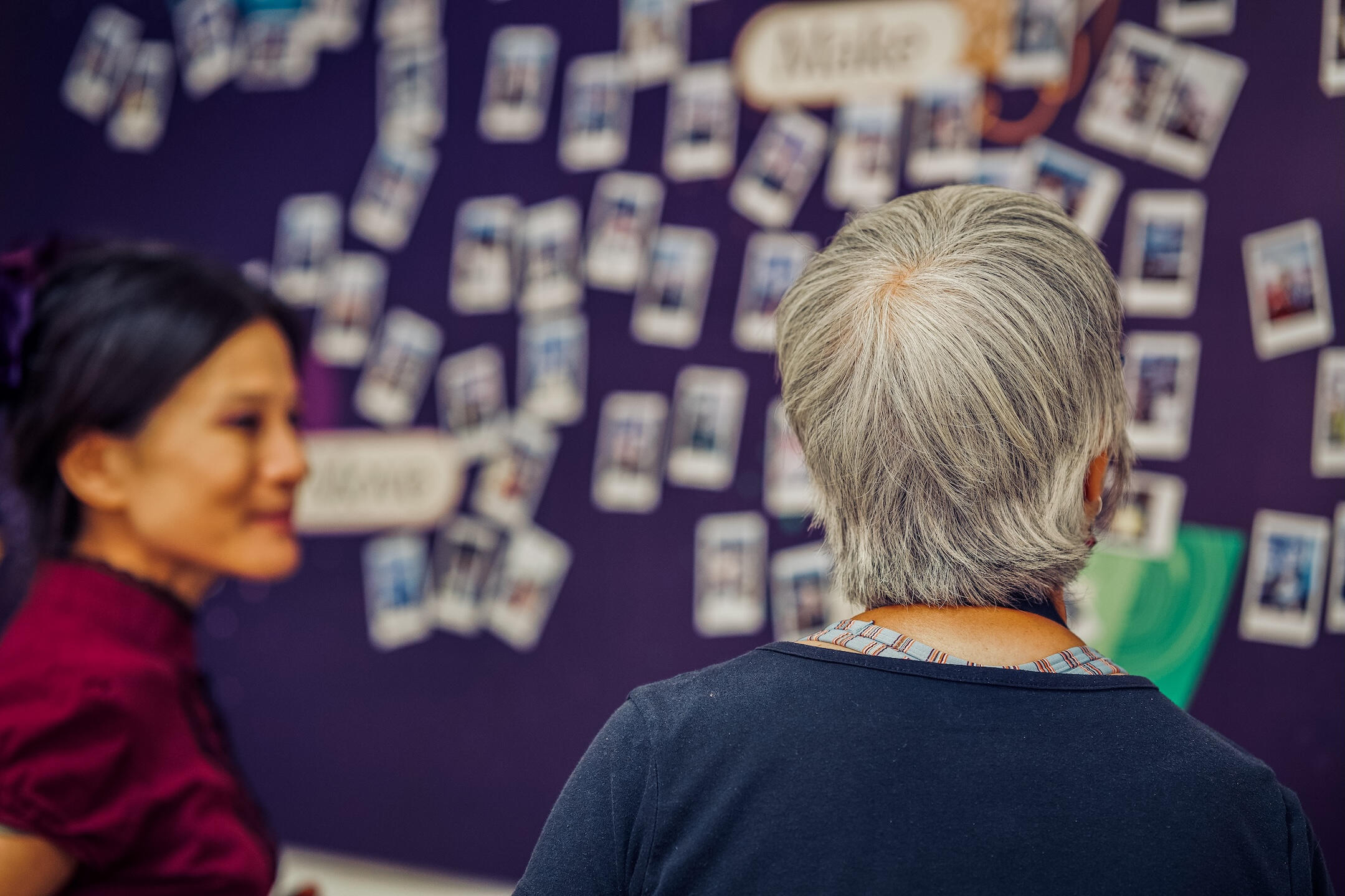
OverviewCuriko is a digital experience platform designed to build meaningful connections between community members with and without disabilities. Through shared experiences—online and in-person—Curiko invites people to explore new interests, challenge ableism, and imagine a more inclusive world.Co-created by InWithForward in partnership with BACI, posAbilities and Kinsight, the platform evolved from Kudoz, a one-on-one learning exchange initiative. In response to stakeholder's interest to scale and pandemic-era isolation, the team reimagined what scalable, relational, and equitable community participation could look like for people traditionally left out of design and tech spaces—especially those with cognitive disabilities.
Sector
Tech for Good
Disability JusticeClient
InWithForward, BACI, posAbilities, KinsightServices
Qualitative Research
Inclusive UX Design
Community Engagement
Accessible Storytelling
Timeframe
2019–2022 (Staff)2022–Ongoing (Contactor)
Approach
Social isolation isn’t new—especially for people labeled with developmental disabilities, who often live on the margins of schools, workplaces, and communities due to systemic ableism. In 2020, COVID-19 surfaced this reality to the wider world, making space for conversations about inclusion, access, and relationships that go both ways. Our challenge was to design a digital-first experience that invites reciprocal, interest-driven interactions while making space for diverse cognitive, sensory, and relational needs.
What happened?
From 2020 to 2022, I was part of a nimble team of social scientists, systems designers, storytellers, and developers working to turn user insights into tangible features through inclusive design and real-time prototyping. I worked cross-functionally using tools like: Figma, GitHub, Miro, Mural, Zoom, Otter.ai, and Slack to collaborate and build community in hybrid spaces. My role supported and sometimes led:
Community-led research & engagement
Designing and facilitating sounding board sessions with disability self-advocates, agency staff, and family members to ensure real community voices shaped development
User experience design
Mapping user flows, co-designing screen layouts, and testing features to support relational experiences and reduce cognitive friction
Collaborative product development
Coordinating with developers to resolve bugs, refine mobile/desktop UI, and bring platform features to life
Qualitative data synthesis
Analyzing ethnographic insights and user testing feedback to shape experience categories, accessibility pathways, and onboarding flows
Accessible storytelling
Creating digital and physical tools that make abstract experiences more tangible (i.e. experience kits, user reflection prompts, marketing assets)
Supporting Accessible Storytelling
After launching the platform in 2022, I transitioned into a contractor role to focus on communications, storytelling, and stakeholder engagement. Ongoing Contributions Include:Monthly Partner Reports that combine backend analytics and user stories to support stakeholder engagementNewsletters and social media that celebrate hosts, spotlight lived experience, and invite curiosity around disability justiceExperience-based marketing materials that reflect accessible storytelling principles and resonate across literacy levels
Check out a past Partner Report here
Key Learnings
Working with the social scientists and systems designers at Curiko deeply shaped how I understand human-centered design. In many sectors, inclusive practices often stop at surface-level accessibility. At Curiko, we had to go deeper—designing with, not just for, people who communicate and process the world differently.This work also sparked my shift toward arts-based and sensory research methods. I started exploring how we can engage people in dignified, equal ways—even when language, literacy, or processing styles differ. Whether it’s through touch, movement, sound, or shared attention, there’s so much potential to meet people where they are—and co-create something beautiful.

Sandy, community co-ordinator at STRIDE Community School

Women's English Speaking Circle at STRIDE Community School
Why it Matters
Curiko isn’t just a platform—it’s a living invitation to be in relationship. To move beyond transactions and into reciprocity, where everyone brings something to the table. For me, it’s a reminder that inclusive design isn’t a checkbox—it’s a commitment to keep learning, unlearning, and being changed by the communities I work with. Whether I’m prototyping an interface or crafting a campaign, I always come back to these questions:
Does it invite people in?
Does it treat them as equals?
Does it leave room for unexpected connection?
Hi! I'm Allison
Part artist, part researcher, part wandering notetaker of the weird and wonderful. I work at the intersection of design, community engagement, and art-based inquiry, creating tools and experiences that help people make sense of themselves and each other.I live and work on the unceded territories of the Musqueam, Squamish, and Tsleil-Waututh Nations — also known as Vancouver, BC — and I’m continually learning how to show up in this place with care, reciprocity, and attention to the stories that came long before mine.My practice is a bit like composting: I gather stories, scraps, feelings, and forgotten things… and turn them into rich nutrients for workshops, drawings, installations, or tiny prompts for reflection. Sometimes these live in classrooms. Sometimes in libraries, parks, or on the side of a fridge.I hold a Bachelor of Design from Emily Carr University, where I focused on human-centered design and systems thinking. I’m a founding member of the artist collective happen stance and currently serve on the steering committee for the Vancouver Design Nerds — a community exploring creativity, care, and collaboration in public space.Curious about the rest of my journey? Check out my LinkedIn for my past work and professional experience.

Services
Creative Facilitation & Community Engagement
Custom Workshop Facilitation – Design and lead hands-on sessions rooted in storytelling, sensory play, and embodied learning.Community Art Engagement – Deliver participatory art experiences for public spaces, schools, or cultural events.Conversation-Based Programming – Host group dialogue using art prompts and co-creation.
Storytelling & Impact & Visual Communication
Impact Reports & Narrative Summaries – Visual, story-driven reports that center lived experience and reflect real-world impact.Partner Reports & Project Documentation – Co-designed materials that help funders and stakeholders understand why a project matter.Ethnographic or Reflective Case Studies – Capture deep insights using accessible and engaging visual storytelling.
Art-Based Design & Research Tools
Design of Engagement Tools – Create custom data collectors, games, or tactile prompts to help people reflect, connect, or share.Art-Based Research & Prototyping – Use creative methods to explore questions, test ideas, and surface insights in accessible ways.Participatory Installation Design – Co-create temporary or mobile artworks that reflect and include community input.
What People Are Saying...
"...an incredible heart throb to read through [this community resource guide]! There's so much work, memories, specific moments, quotes you somehow managed to pack in! Your writing is brilliant! The featured stories are so powerful! It all feels so personal. Thank you so much for the hard work you have done pulling together years of content! I'm especially impressed since you did this all during the most intense/chaotic period this team has seen."— GEORGE, UNITED WAY PROJECT LEAD
“I’ve really appreciated and admired Allison’s capacity to craft juicy and compelling newsletters for our community plus multi-faceted partner reports for our funders and allies. She is able to transform our data, stories and updates into visually appealing, flowing, accessible and engaging assets! I actually enjoy reading what she creates from our source materials so thank you so much Allison for all your communications magic!”_— LITTLEWOO, CURIKO LEARNING COACH

Past Collaborators & Creative Partners...
Contact
Got an idea, collaboration, or curious question? Book a quick call or drop me a note using the form below — I’d love to hear from you.Not ready to chat? No worries. Subscribe to my Substack for occasional studio musings, or come say hi on Instagram at @the.good.imp where I post glimpses of process, and things that inspire me.
Thank you
Your message is fluttering its way to my inbox, and I’ll get back to you soon!In the meantime, feel free to subscribe to my Substack for occasional studio updates and creative reflections.
